Advertisement

10 'Star Trek' Technologies That Actually Came True
- Share Content on Facebook
- Share Content on LinkedIn
- Share Content on Flipboard
- Share Content on Reddit
- Share Content via Email
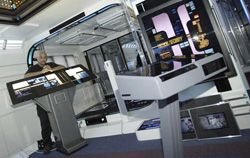
"Beam us up." It's one of the most iconic lines in television history. It's something often heard in the hit science fiction television series "Star Trek" and all of the television shows and movies that followed.
The transporter essentially dematerialized a human body at one point only to rematerialize it in the transporter bay on the ship. Somehow, it broke down atoms and molecules within the body -- scattered them through the vacuum of space without losing a single one from point A to point B, then voila, that person re-emerged out of thin air. Sounds pretty cool, though impossible, right? But what if there was such a device?
The truth is, you can forget about a transporter. No one has been able to realize such a concept. But that doesn't mean some of the ideas that seemed far-fetched when the show debuted in 1966 haven't become a reality. In this article, we feature the top 10 technologies from Star Trek that actually did come to fruition, listed in no particular order. Some of them may surprise you.
- Transparent Aluminum (Armor)
- Communicators
- Tractor Beams
- Universal Translator
- Geordi's VISOR
- Torpedo Coffins
- Telepresence
10: Transparent Aluminum (Armor)
The fourth installment of the original "Star Trek" movies is perhaps the most endearing to fans. The crew returns to modern-day Earth. Kirk, Spock and the rest of the gang ditch a Klingon Bird of Prey spacecraft in the San Francisco Bay after narrowly missing the Golden Gate Bridge while flying blind in a storm. You may remember the scene -- but how many of you remember Scotty introducing transparent aluminum for the first time?
In the flick, Scotty traded the formula matrix for transparent aluminum -- a huge engineering advancement -- for sheets of plexiglass in order to build a tank to transport the two humpback whales (George and Gracie) to the Earth of their time. The claim was that you'd be able to replace six-inch (14-centimeter) thick Plexiglas with one-inch (2.5-centimeter) thick see-through aluminum.
It may sound impossible, but there is such a thing as transparent aluminum armor or aluminum oxynitride (ALON) as it's more commonly known. ALON is a ceramic material that starts out as a powder before heat and pressure turn it into a crystalline form similar to glass. Once in the crystalline form, the material is strong enough to withstand bullets. Polishing the molded ALON strengthens the material even more. The Air Force has tested the material in hopes of replacing windows and canopies in its aircraft. Transparent aluminum armor is lighter and stronger than bulletproof glass . Less weight, stronger material -- what's not to like?
9: Communicators
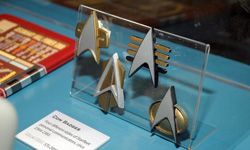
Whenever Captain Kirk left the safe confines of the Enterprise, he did so knowing it could be the last time he saw his ship. Danger was never far away. And when in distress and in need of help in a pinch, he could always count on Bones to come up with a miracle cure, Scotty to beam him up or Spock to give him some vital scientific information. He'd just whip out his communicator and place a call.
Fast-forward 30 years and wouldn't you know it, it seems like everyone carries a communicator. We just know them as cell phones . Actually, the communicators in "Star Trek" were more like the push-to-talk, person-to-person devices first made popular by Nextel in the mid to late '90s. The "Star Trek" communicator had a flip antenna that when opened, activated the device. The original flip cell phones are perhaps distant cousins. Whatever the case, the creators of "Star Trek" were on to something because you'd be hard-pressed to find many people without a cell phone these days.
In later incarnations of the "Star Trek" franchise, the communicators evolved to being housed in the Starfleet logo on the crewman's chest. With the tap of a finger, communication between crewmembers became even easier. Vocera Communications has a similar product that can link people on the same network inside a designated area like an office or a building by using the included software over a wireless LAN. The B2000 communication badge weighs less than two ounces and can be worn on the lapel of a coat or shirt and allows clear two-way communication. It's even designed to inhibit the growth of bacteria so it's suitable for doctors [source: Vocera ].
8: Hypospray
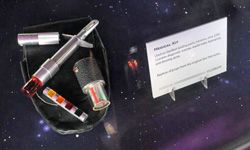
The creative team behind "Star Trek" found spiffy ways to spice up some activities we endure on a day-to-day basis. Take medical treatment, for example: Not many people enjoy getting a flu shot, and in "Star Trek," inoculating patients was one of Dr. Leonard "Bones" McCoy's primary duties. It seemed not an episode went by that Bones wasn't giving someone a shot of some sort of space vaccine . But what was more fascinating was the contraption he used.
Hypospray is a form of hypodermic injection of medication. A hypospray injection is forced under the skin (a subcutaneous injection) with high air pressure. The air pressure shoots the liquid vaccine deep enough into the skin that no needle is required. The real-world application is known as a jet injector .
Jet injectors have been in use for many years. In fact, the technology predates "Star Trek." Jet injectors were originally designed to be used in mass vaccinations. Jet injecting is safer (no needles to pass along infectious disease) and faster in administering vaccines. Similar in appearance to an automotive paint gun, jet injection systems can use a larger container for the vaccine, thus allowing medical personnel to inoculate more people quicker.
7: Tractor Beams
When NASA needs to make repairs to the Hubble Space Telescope, astronauts have to be specially trained to get out of the Space Shuttle for extravehicular activity. They also have to learn how to work within the confines of their space suits, with thick gloves on. Wouldn't it be nice to just bring the telescope inside, where repairs wouldn't be so challenging and dangerous?
In science fiction, space ships including the Starship Enterprise snatch each other up using tractor beams. In some cases, large vessels have a tractor beam strong enough to prevent smaller vessels from escaping the gravitational force. So is this science even plausible?
Yes and no. Optical tweezers are as close as you're going to get to a legitimate tractor beam on current-day Earth. Scientists have harnessed small lasers into beams capable of manipulating molecules and moving them with precision. Optical tweezers use a focused laser to trap and suspend microscopic particles in an optical trap. Scientists can use optical tweezers to trap and remove bacteria and sort cells. Optical tweezers are used primarily in studying the physical properties of DNA. While the beams used in optical tweezers aren't strong enough to dock the space shuttle to the International Space Station, it's a start in that direction.
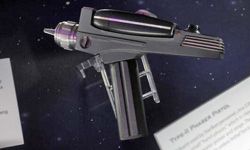
"Set phasers to stun" -- another oft-heard command given to the Enterprise crew. The crew often relied on the stun setting of their fictitious weapon of choice known as a phaser. Armed with a phaser, Kirk and his colleagues had the ability to kill or more desirably, stun their adversaries and render them incapacitated.
Actually, stun guns have been around for some time. In fact, electricity has been used for punishment and to control livestock as far back as the 1880s. But it wasn't until 1969 when a guy named Jack Cover invented the first Taser that the stun gun was most realized. The Taser fails to kill like the phaser did, yet, it packs enough of an electrical punch to render its victim disorientated, if not completely incapacitated.
Unlike the phaser, the Taser and other stun guns must come in physical contact with the target in order to have any effect. Tasers take care of this by projecting two electrodes, connected by wires, which attach to the target's skin. Once in contact, the handheld unit transfers electricity to the target, thus having the stun effect. Stun guns with stationary electrical contact probes are somewhat less effective because while they have a similar effect on the target, you have to be much closer (within arm's length) in order to zap your target.
Something more along the lines of the phaser may be in development. Applied Energetic has developed Laser Guided Energy and Laser Induced Plasma Energy technologies that are said to transmit high-voltage bursts of energy to a target [source: Applied Energetics ]. In other words, these pulses of energy would stun the target and limit collateral damage. So a true phaser may soon be a reality.
5: Universal Translator
Imagine if no matter what country you visited, no matter what the culture, you could understand everything the indigenous people were saying. It sure would make traveling easier. Take that thought to another level like say, if you were planet hopping like the crew onboard the Enterprise. Fortunately for Captain Kirk and his peers, they had a universal translator .
The characters in "Star Trek" relied on a small device that when spoken into, would translate the words into English. Guess what? The technology exists for us in the real world. There are devices that let you speak phrases in English and it will spit back to you the same rhetoric in a specified language. The only problem is, these devices only work for certain predetermined languages.
A true universal translator like the one on the show may not be a reality, but the technology is available. Voice recognition has advanced considerably since its inception. But computers have yet to be able to learn languages. Computers would be able to theoretically gather the information much faster than a human brain, but a software program is dependent on actual data. Someone has to take the time and expense to put it together and make it available, which is probably why these systems focus on more popular languages.
4: Geordi's VISOR
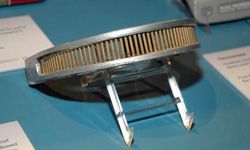
When "Star Trek: The Next Generation" thrust the love of everything "Star Trek" back into popular culture, the quirky Mr. Spock and crass Bones McCoy and others were supplanted by a new cast. One of the most popular characters on the new show was engineer Geordi LaForge.
What made Geordi unique, perhaps even mysterious, was his funky eyewear. Geordi was blind, but after a surgical operation and aided through the use of a device called VISOR (Visual Instrument and Sensory Organ Replacement), Geordi could see throughout the electromagnetic spectrum. Though it may sound far-fetched, in reality, similar technology exists that may someday bring sight back to the blind.
In 2005, a team of scientists from Stanford University successfully implanted a small chip behind the retina of blind rats that enabled them to pass a vision recognition test. The science behind the implants, or bionic eyes as they're commonly referred to, works much the way Geordi's VISOR did. The patient receives the implants behind the retina, then wears a pair of glasses fitted with a video camera. Light enters the camera and is processed through a small wireless computer, which then broadcasts it as infrared LED images on the inside of the glasses. Those images are reflected back into the retina chips to stimulate photodiodes. The photodiodes replicate the lost retinal cells then change light into electrical signals which in turn send nerve pulses to the brain.
What it all means is that in theory, a person with 20/400 sight (blind), due to the loss of retinal cells from retinitis pigmentosa, can obtain 20/80 sight. It's not good enough to pass the driving test (normal vision is considered 20/20) but it's good enough to read billboards and go about your day without the aid of a seeing-eye dog.
3: Torpedo Coffins
In the second installment of the "Star Trek" movie franchise, the beloved Mr. Spock, played by Leonard Nimoy, died after saving the Starship Enterprise from certain disaster. The movie culminated with the crew firing Spock's corpse out of the torpedo bay in a coffin shaped like one of the ship's weapons, the photon torpedo .
Believe it or not, you too could be laid to eternal rest in your own Federation-approved photon torpedo casket. OK, it may not technically be Federation-approved since there is no such thing as the United Federation of Planets (UFP) but the coffins are, in fact, very real.
Designed by Eternal Image, the "Star Trek" coffin was slated to be available early 2009, but is still not for sale as of this writing. The price is yet to be determined. If the fan would prefer to be cremated , the company also plans to offer a "Star Trek" urn as well.
2: Telepresence
In 1966, the idea of interacting with each other while separated by the void of space seemed as far fetched as, well the idea of being in space. That's precisely what the idea of telepresence is.
Telepresence is more than just video conferencing . The visual aspect is important and immersion is vital. In other words, the more convincing the illusion of telepresence, the more you feel like you're there.
In 2008, AT&T teamed up with Cisco in delivering the industry's first in-depth telepresence experience. The key to Cisco's TelePresence is the combination of audio, video and ambient lighting working together. These telepresence kits are designed to mirror surroundings and mimic sounds so that users on each side of the video conference will feel as though the images on the screen are in the same room with them. For instance, the people in boardroom A will see the people on the screen in boardroom B as though they are sitting across the table from them. The ambient lighting and room features are constructed to mirror each other. Sure, these telepresence kits are much more advanced than anything drummed up on "Star Trek," but perhaps that's because the show sparked our imagination so many years ago.
1: Tricorders
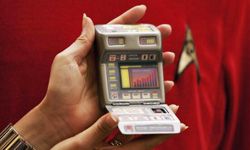
How many of you remember that instrument Mr. Spock used to always carry over his shoulder, especially when the crew (usually consisting of only Spock and Captain Kirk) first surveyed a new planet? That was a tricorder.
One of the more useful instruments available to "Star Trek" personnel, variations of the tricorder (medical, engineering or scientific) were used to measure everything from oxygen levels to detecting diseases. Often times the tricorder gave an initial analysis of the new environment. So, what's the real-world tie-in? NASA employs a handheld device called LOCAD, which measures for unwanted microorganisms such as E. coli, fungi and salmonella onboard the International Space Station [source: Coulter ]. Beyond that, two handheld medical devices may soon help doctors examine blood flow and check for cancer, diabetes or bacterial infection.
Scientists at Loughborough University in England use photoplethysmography technology in a handheld device that can monitor the functions of the heart. Meanwhile, researchers at Harvard Medical School have developed a small device that utilizes similar technology found in MRI machines that non-invasively inspect the body. Using nuclear magnetic resonance imaging, this device would be sensitive enough to measure samples of as few as 10 possible infectious bacteria. This kind of sensitivity (800 times more sensitive than sensing equipment currently used in medical labs) could revolutionize the way doctors diagnose disease [source: Mick ].
Lots More Information
Related howstuffworks articles.
- 10 Essential Gadgets
- 10 Long-running TV Shows
- Who Said It: Captain Kirk or Picard?
- How Stun Guns Work
- How Military Pain Beams Will Work
- How Transparent Aluminum Armor Works
- How Does "Bulletproof" Glass Work?
- What makes glass transparent?
- How Military Snipers Work
- How Body Armor Works
- How Liquid Body Armor Works
- How Warp Speed Works
- How Antimatter Spacecraft Will Work
- How Rocket Engines Work
- How Sci-Fi Doesn't Work
- Do parallel universes really exist?
- How Time Travel Will Work
- How Teleportation Will Work
More Great Links
- "Star Trek" Official Home Page
- U.S. Air Force
- Applied Energetics. "Laser Guided Energy." (Nov. 9, 2009) http://ionatron.net/laser-guided-energy.asp
- AT&T. "AT&T first service provider to deliver intercompany Cisco telepresence for business around the world." April 21, 2009. (Oct. 21, 2009) http://www.att.com/gen/press-room?pid=4800&cdvn=news&newsarticleid=25523
- Bartkewicz, Anthony. "Company creates Star Trek coffins." KRQE.com. April 6, 2009. (Oct. 21, 2009) http://www.krqe.com/dpp/news/strange/offbeat_dpgo_Company_creates_Star_Trek_coffins_SAB_040420092296082
- Batchelor, David Allen. "The Science of Star Trek." NASA. (Oct. 22, 2009) http://ssdoo.gsfc.nasa.gov/education/just_for_fun/startrek.html#transporter
- BBC News. "'Star Trek device' could detect illness." Sept. 20, 2002. (Oct. 20, 2009) http://news.bbc.co.uk/2/hi/health/2231989.stm
- Cisco. "Telepresence: Product information." (Oct. 21, 2009) http://www.cisco.com/en/US/products/ps7060/index.html#,hide-id-trigger-g1-room_environments
- Coulter, Dauna. "Space Station Tricorder." Science@NASA. May 9, 2008. (Nov. 6, 2009) http://science.nasa.gov/headlines/y2008/09may_tricorder.htm?list185546
- Cruz, Gilbert. "Jack Cover." Time Magazine. Feb. 19, 2009. (Oct. 19, 2009) http://www.time.com/time/magazine/article/0,9171,1880636,00.html
- Lundin, Laura. "Air Force testing new transparent armor." U.S. Air Force. Oct. 17, 2005. (Oct. 21, 2009) http://www.af.mil/news/story.asp?id=123012131
- Mick, Jason. "New "miracle diagnosis" handheld medical scanner 800 times more sensitive than full-size scanners." Daily Tech. July 10, 2008. (Oct. 21, 2009) http://www.dailytech.com/article.aspx?newsid=12322
- National Institute of Standards and Technology. "Optical Tweezers." (Oct. 20, 2009) http://physics.nist.gov/Divisions/Div842/Gp4/Tweezers/research.html#polymerosomes
- Schirber, Michael. "Doctors could go needle-free, but sticking points remain." Live Science. Oct. 4, 2006. (Oct. 21, 2009) http://www.livescience.com/health/061004_needle_free.html
- Stanford.edu."Optical tweezers; an introduction." (Oct 22, 2009) http://www.stanford.edu/group/blocklab/Optical%20Tweezers%20Introduction.htm
- Star Trek.com. (Oct. 20, 2009) http://www.startrek.com/startrek/view/library/characters/TNG/bio/1112463.html
- Vocera. (Oct. 22, 2009) http://www.vocera.com/products/products.aspx
- Young, Kelly. "'Bionic eye' may help reverse blindness." New Scientist. March 31, 2005. (Oct. 22, 2009) http://www.newscientist.com/article/dn7216
Please copy/paste the following text to properly cite this HowStuffWorks.com article:
Screen Rant
15 star trek gadgets that exist in real life.
Star Trek has been instrumental in inspiring many modern technological wonders. Here are some of the most impressive predictions the show made.
Later this year, fans of the legendary science fiction television series Star Trek will celebrate the fiftieth anniversary of its original broadcast. With its optimistic view of a future that sees people of all races cooperating for the good of humanity, Star Trek was ahead of its time in many respects, and in the years since, subsequent stories within the franchise have gone further to predict the development of the human race.
In the years since its debut, Gene Roddenberry’s most famous work has gone on to inspire a wide variety of scientific breakthroughs and developments. Many of the gadgets and household technological marvels that are taken for granted now were initially popularized on Star Trek , and in many cases, inventors have looked directly to the show for inspiration on how to develop practical uses for new discoveries and inventions.
Here are 15 times that Star Trek predicted the technology of modern life:
15. Big Screen Television
It’s hard to think now of what watching the original series of Star Trek at the time of its initial broadcast would have been like. Televisions of the 1960s were a far cry from the large, high definition marvels of modern life, and it’s no doubt that the limitations of the TV sets of the era went some way to hide the less impressive elements of production, such as poorly choreographed fights and cheesy special effects, which modern viewers of the show enjoy poking fun at.
It’s interesting to think that in many ways, Star Trek pioneered the idea of large screen displays – when the show initially debuted, the idea of a large television or computer screen that displayed lifelike visuals was completely unheard of. In the years since Star Trek first aired, great advancements have been made in producing bigger, brighter, and clearer television sets – that the show predicted this development decades before the technology was a reality is a pretty impressive insight into the future.
14. Cellular Phones
Probably the most obvious prediction that the original Star Trek series got right, the idea of personal communicators that could be used as portable telephones was a fantastical concept back in 1966 that is an often overlooked technological marvel today.
To a certain extent, it’s difficult to separate where Star Trek ’s prediction of phones ends, and its actual influence on the development of the technology begins. Martin Cooper, the man often credited with the invention of the first viable cellular phone, has stated publicly that he was very much inspired by the version of mobile communicators put forward by Star Trek . As the technology further developed, Star Trek ’s influence would grow, as phone developers went on to create flip phones that exactly matched the props used in the television series.
While flip phones have since been replaced with smartphones for most people, this evolutionary step for the technology comes straight from the world of Star Trek , and it’s worth wondering how phones might have developed differently without the show.
13. Teleporters
Scientists have been working to create viable teleportation for decades – such technology would make transport of goods and even people across vast distances far easier. Throughout this time, whenever the subject of teleportation comes up, it’s difficult to avoid thinking of the portrayal of the technology in Star Trek .
While human teleportation is still a long way from being feasible, scientists are making progress on the concept. Many different versions of teleportation have been explored – one key development is known as quantum teleportation , which involves sending information regarding atomic locations between two points. While the experiments in quantum teleportation may well lead to the teleportation of larger objects in future, it also goes a long way to solving another technological challenge from Star Trek : the ability to communicate across vast distances instantaneously – radio waves are only capable of travelling at the speed of sound, after all, and are therefore unhelpful for communicating across the vast depths of space.
For a more practical form of teleportation, one German company has proposed an alternative solution : a 3D printer which scans an object and produces an exact replica at another location. This could also prove the first steps towards being able to instantaneously transport items across vast distances, although for obvious reasons it’s hardly ready for human use just yet.
12. Intelligent Personal Assistants
Star Trek features many computers which users can speak directly to and receive logical, sensible answers from a device that both understands human speech, and is able to respond in kind, without the need for any kind of viewscreen or other inputs.
While even as little as a decade ago this technology seemed completely impossible, now many smartphone and computer users regularly engage in voice activated conversation with digital personal assistants such as Siri and Cortana.
Developments to make these devices smarter is ongoing, and with scientists making inroads to producing machines that can pass the Turing Test (an experiment to see if a computer can accurately fool users into thinking they’re talking to a human), this technology will continue to develop to be smarter at interpreting our needs. That said, a recent AI project created by Microsoft to interpret and learn from online communications had to be shut down as it was influenced too much by internet hatespeech, so there’s still some way to go before this technology is perfected.
11. Replicator
The concept of a replicator – a device that can produce any object instantly from a digital blueprint – is one that fits right in with the advanced near-magic technology of the Star Trek universe. In creating such a device for the show, it wasn’t necessary to think too hard about the scientific logic behind the replicator, and the convenient macguffin features as a central element of several Next Generation episodes.
In reality, though, replicators are becoming a more affordable item every day, as the price of 3D printers drops dramatically. While 3D printers lack many of the capabilities of Star Trek ’s replicators – for example, most printers can’t produce food and can only use plastic as a building material – there is a wealth of practical applications for the device.
In particular, it’s expected that as 3D printers become more widely accessible, repair costs for devices such as washing machines will drop, as customers will be able to download replacement parts directly to their 3D printers, saving a lot of time and hassle to keep household machines running smoothly.
10. Universal Translator
In a show that deals with the difficulties and nuances of interactions between a variety of alien races , Star Trek needs a simple way of explaining away communication barriers. While in many instances aliens conveniently speak fluent English, other circumstances call for a universal translator: a device that can instantly listen to any language and output a second language for the user to understand.
While Google Translate has for many years been the butt of jokes surrounding automatic translation, many companies are making real headway in developing translation software that can not only cope with complex sentences, but can produce a translation instantaneously simply by listening to the speaker.
Versions of this software are available as smartphone apps, while more complex and sophisticated version of the technology have plenty of practical applications in embassies, airports, and other international areas around the world.
9. Hands Free Phones
As the chief communications officer of the Enterprise, Lieutenant Uhura is often depicted across the course of the original Star Trek series wearing an earpiece that allows her to keep tabs on communications both across the ship and with external threats .
In what is likely another case of Star Trek ’s interpretation of technology being used as the basis for real world inventions, modern day hands-free Bluetooth earpieces strongly resemble the technology used by Uhura as part of her job.
A similar device appears in the modern Star Trek movies, and it’s interesting to note that this form of technology, like much in the show, doesn’t successfully feel as advanced and futuristic as it did at the time of the original show. Considering the technological advancements that have been made over the past fifty years, it’s no wonder JJ Abrams had to make such heavy use of lens flares in order to make his movie feel scientific and visually impressive – tricks the original show did through the use of fantastical props.
8. Tricorder
Another key staple of the Star Trek original series, the tricorder is a pocket computer that’s capable of scanning the landscapes and inhabitants of alien worlds for various pieces of data, such as mineral deposits, heat signatures, and in the case of the medical version, diseases or other maladies.
As with other pieces of technology on this list, it’s often difficult for scientists to talk about scanners that they build for technological purposes in real life without referencing Star Trek ’s tricorder. Various medical devices are able to scan patients to learn about injuries, such as the Handheld DNA Lab by QuantuMDx , which can scan a patient to give a diagnosis of illness in fifteen minutes.
Similarly, other machines are used for scanning the ground to gain a better understanding of its layout and composition. As far back as 1996, the Vital Technologies Corporation has created what it called the ‘Official Star-Trek Tricorder Mark 1’, which is designed to perfectly mimic the appearance and capabilities of the Star Trek device.
7. Tablet Computers
When Star Trek: The Next Generation debuted years after the original series, a concerted effort was made to make the technology of the new show stand out from its predecessor. Among the new additions to Star Trek ’s technological capabilities is the concept of a flat, touchscreen computer device, no thicker than a magazine, but with significant computing power. At the time, such devices were only possible in the most distant of science fiction dramas, and it was hard to imagine a near future where such machines could be possible.
The first commercially successful tablet computer of any mainstream popularity, the iPad, debuted six years ago in 2010. In the time since then, modern life has seen the introduction of a variety of tablet computer devices, ranging from the laughably cheap to the impressively sophisticated. It’s safe to say that this is one prediction that Star Trek not only got right, but if anything underestimated just how prevalent touchscreen computers would become in the near future.
6. Eye-Top Computers
There are multiple devices which appear over the course of The Next Generation which bear more than a passing resemblance to Google Glass. The machines are typically used in Star Trek as a quick and convenient answer to heads up displays, providing precision guidance for weapons or medical tools by giving the user a better, more detailed view of what they’re doing.
In practice, while Google’s ill-fated eye-top computer may have looked similar to these devices, it didn’t have quite the functionality of the machines envisioned by Star Trek . While the Google Glass didn’t manage to take off, there are a range of ongoing projects within the tech world, researching the viability of augmented reality to create heads up displays that can help guide the user through their daily tasks. Most notably, Microsoft is currently developing what the company is calling the HoloLens , which involes an eye-top machine that projects hologram-like images into the user’s line of vision, copying yet another classic Star Trek technology. Among the experts working on the project is none other than Casey Hudson, director of the Mass Effect trilogy of games, which also took more than a little inspiration from Star Trek .
5. Video Calls
At the time that the original Star Trek series debuted, the idea of seeing video when talking to someone on the phone wasn’t a new concept, but it was a long way from being commercially viable. The technology required to make this element of science fiction a reality has existed for several decades, but it took a long time for the idea to take off among the public. Telecommunications companies tried several times to get the public excited about 3G video phone calls, but due to the expense of the phones required, the cost of using networks for this purpose, and the fact that anyone a person wanted to call also needed to have a video phone, early attempts to introduce the technology fell flat.
It was only once smartphones and high speed internet became commonplace that cheap, convenient video calls became a reality. Now, this technology is a common part of everyday life, and it’s hard to imagine a world ten years ago that was skeptical about video phones ever becoming a popular reality.
4. Tractor Beams
Star Trek ’s tractor beam, a concept that has appeared in science fiction since the 1930s, rests on the idea of a high powered energy beam locking on and attracting a foreign object, spaceship, or person. The idea, originally called an ‘attractor beam’, has appeared in a wide range of science fiction stories in the years since its original inception.
Scientists have been working for a long time to try and bring tractor beams into reality. In 2015, a team of UK-based engineers made the announcement that they’d invented a way to use soundwaves to move tiny objects of up to 5mm in size physically without touching them. The scientists stated that they believe such technology in its current form has a lot of potential for medical usage, and it’s expected that further study will lead to the development of larger, more powerful tractor beams that can move heavier objects in the future.
The weapons in Star Trek don’t rely on bullets or other projectiles – instead, phasers shoot bolts of energy which can be set to either cause serious damage to an opponent, or simply stun them for a short time, thereby being useful in situations where the user doesn’t want to kill their target.
Real-world alternatives to phasers, which use electric energy to incapacitate enemies have been in use since the 1970s – the most common brand name for these devices is the Taser, which, much like the stun setting of phasers in Star Trek , generally won’t do permanent damage to people that the device is used on.
While Tasers don’t quite have the science fiction sheen that Star Trek phasers do on the show, the devices work on a similar principle, and advancements are being made to the technology all the time to make them more effective and formidable for use against a variety of opponents.
2. Bionic Eyes
Star Trek: The Next Generation features a character called Geordi La Forge, who is blind but is able to see through the use of a special visor that provides a wealth of information to his brain about the various energy waves which surround him. In later appearances in Star Trek , the character is instead shown with cybernetic eyes which have replaced his own and which provide him with a similar view of energy waves around him.
The technology required to bypass the human eye and provide a measure of sight to the blind has existed for a while, although it’s still very much in its infancy. As far back as 2006 , scientists were using cameras which connect to the user’s brain to provide limited sight to some blind patients. Various studies by major universities are currently ongoing to produce glasses and other peripherals which can completely restore sight to the blind.
1. Personal Computers
Modern computer users are often spoiled for choice when compared with the technology that was available fifty years ago – between miniature computer smart phones, tablet computers, and desktop machines, it’s common to own multiple personal computers and to even use several of them at the same time for different tasks.
It’s easy to forget that at the time of Star Trek ’s initial broadcast, the idea of a powerful personal computer was decades away from fruition. Computers of the era were enormous devices that required a lot of space and were prohibitively expensive, meaning that seeing ensigns about the starship Enterprise working on personal computers was an unbelievable concept.
It’s likely for this reason that many computers within the show were voice activated – even the idea of a keyboard and mouse were a long way from development during the 1960s, and not all computers aboard the Enterprise even had their own monitors or screens. The primitive bulky computers that appear in the early television series are laughable in their inaccuracy, but Star Trek did successful predict that one day computers would become small enough and cheap enough for commonplace personal use.
The world has changed a lot since Star Trek initially debuted. As fans gear up for a third instalment in the new, rebooted Kelvin timeline , it’s worth remembering not just how far the show has developed over the past fifty years, but also how far humanity has come.
Star Trek may not have been the original source of many of the ideas on this list, but the television show certain popularized many science fiction concepts that were later created in real life, often by scientists who’d first been inspired by watching the adventures of Captain Kirk and his crew. For providing that inspiration, Gene Roddenberry’s science fiction universe deserves significant respect and gratitude.
Which other inventions has Star Trek influenced? Which is your favorite technology on this list? Share your thoughts in the comments section below.
The Top 10 Star Trek Technologies
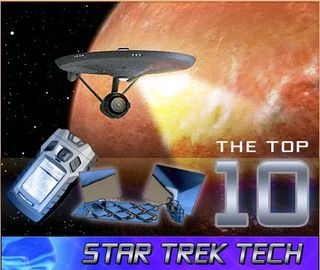
Classic Star Trek contributed more to the modern world than phrases like "Beam me up, Scotty!" Many of the devices we saw decades ago are now available for use in the real world; we thank the engineers who made real these ten Star Trek technologies. - Bill Christensen, Technovelgy.com
Behold, the Cell Phone
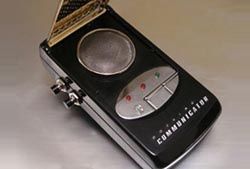
Star Trek popularized the idea of a communicator that could instantly connect two crew members on different parts of a planet. To answer the device, you just flipped it open and started talking. Of course, everyone recognizes this device today as a cell phone. Amateur electronics wizards have occasionally made replica Star Trek communicators available on eBay; they use Bluetooth technology to piggyback on your cell phone service.
Handy Medical Tools
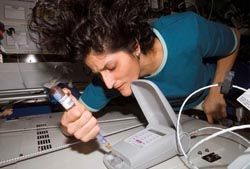
When Enterprise crew members became sick, Dr. McCoy was able to diagnose the problem in record time, usually thanks to his medical tricorder . Today's physicians make use of Magnetic Resonance Imaging (MRI) and CAT scans in much the same way. For smaller bugs, NASA has actually tested a similar kind of device on the space station. The LOCAD-PTS is able to detect and identify within minutes environmental pathogens (fungi or bacteria) that could adversely affect the health of crew members.
Say What? Translators from Google and Co.
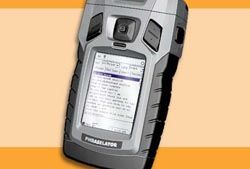
The Enterprise constantly dealt with intelligent beings throughout the galaxy. When different languages were encountered, the Universal Translator was there to help bring different cultures together. In the real world, the US military is using the Phraselator in Iraq for speech translation and Internet juggernaut Google, among others, can translate Web sites to suit user needs. Also, just this month, NEC announced the first cell phone with speech translation .
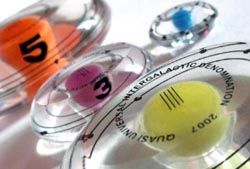
When the crew of the Enterprise received a well-deserved shore leave, they needed some kind of money to buy goods and services. The science fiction standby of "credits" was usually brought into the picture. Today, however, real-life astronauts can use colorful QUID's (Quasi Universal Intergalactic Denomination), which are specially designed for use in space .
Global Positioning System Devices

The Enterprise's transporter was able to zero in on the exact location of an individual crew member from thousands of miles away. Although we're still working on teleportation (see USAF Looks Into Teleportation ), we've pretty much got the location technology down pat. It's called the Global Positioning System - GPS. One such satellite, one of Europe's planned Galileo network, is shown above.
Mars Rover Sensors

Whenever Spock beamed down to a planetary surface, there was one thing he always took with him - his trusty tricorder . This handy pocket-sized device could do things like analyze the minerals in soil and look for life signs. NASA is ready to send similar sensors to Mars in coming years, like the Raman spectrometer shown above.
Focused Ultrasound Surgery
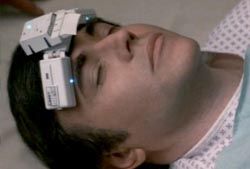
This surgical technique is a non-invasive way to destroy unwanted masses within the body (like uterine fibroids) without harming the surrounding tissues. I seem to recall Dr. McCoy touting the advantages of doing surgery without using knives decades ago. On one occasion, he saved Chekov with a nifty little non-invasive surgery device ( see photo ), saying "Put away your butcher knives and let me save this patient before it's too late!"
Transparent Aluminum Armor
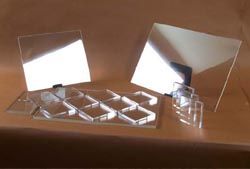
Transparent aluminum armor (aluminum oxynitride - ALON) is being tested by the military as a lighter and stronger alternative to traditional materials. ALON is a ceramic compound with very high compressive strength and durability; it offers better performance than traditional materials consisting of bonded glass. in extensive testing, ALON has performed well against multiple hits of armor-piercing rounds. Trek fans fondly recall how the formula for (science-fictional) transparent aluminum came to our time; Scotty blabbed it to an engineer ( see photo ).
Military PHASR
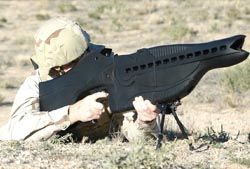
Several prototype PHASR weapons are being tested by the US military. The Personnel Halting and Stimulation Response device is under development at the Air Force Research Laboratory's Directed Energy Directorate. The PHASR has been designed as a non-lethal, man-portable deterrent weapon. It uses a laser system with two different wavelengths to blind (temporarily!) the enemy. The clever acronym for this device is obviously back-formed to resemble its original - the phaser rifle from Star Trek, which actually looks very similar ( see another photo ).
Life Detectors

A robotic rover called Zoe is the first robot to remotely detect the presence of life. On a NASA-sponsored mission in the harsh Atacama desert in Chile, Zoe was able to detect life by looking for natural fluorescence from lichens and bacteria. Life detection is all the rage now; the European Space Agency will be using the Urey Life Detector on an upcoming Mars mission ( see photo ). These devices mimic the function of the long range sensors from Star Trek, which could detect life from unreasonably long distances.
Join our Space Forums to keep talking space on the latest missions, night sky and more! And if you have a news tip, correction or comment, let us know at: [email protected].
Get the Space.com Newsletter
Breaking space news, the latest updates on rocket launches, skywatching events and more!

Space.com is the premier source of space exploration, innovation and astronomy news, chronicling (and celebrating) humanity's ongoing expansion across the final frontier. Originally founded in 1999, Space.com is, and always has been, the passion of writers and editors who are space fans and also trained journalists. Our current news team consists of Editor-in-Chief Tariq Malik; Editor Hanneke Weitering, Senior Space Writer Mike Wall; Senior Writer Meghan Bartels; Senior Writer Chelsea Gohd, Senior Writer Tereza Pultarova and Staff Writer Alexander Cox, focusing on e-commerce. Senior Producer Steve Spaleta oversees our space videos, with Diana Whitcroft as our Social Media Editor.
Everything we know about James Gunn's Superman
This Week In Space podcast: Episode 108 — Starliner: Better Late Than Never?
Mars exploration, new rockets and more: Interview with ESA chief Josef Aschbacher
Most Popular
- 2 Everything we know about James Gunn's Superman
- 3 Sneak peek: Browncoats grab victory in Boom! Studios' upcoming 'Firefly: 'Verses' comic (exclusive)
- 4 SpaceX launches 23 Starlink satellites from Florida
- 5 NASA's mission to an ice-covered moon will contain a message between water worlds
12 Star Trek Gadgets That Now Exist
By john brandon | oct 29, 2015.
For geeks growing up in the 1960s, '80s and '90s, a vision of the future has been provided by one very successful television franchise: Star Trek. And the future, it turns out, is coming sooner than even Trek 's writers could have imagined. Here are 12 gizmos used on the Star Trek television shows that are now becoming real.
1. Food Replicator
Captain Jean-Luc Picard used to say "Tea, Earl Grey, hot!" and it would be replicated instantly. Today's 3D printers don't tackle tea, but there are machines that actually can print food. And other printers, like the MakerBot Replicator 2 are quite adept at making small objects—just as they were shown to do on later episodes of Star Trek: The Next Generation .
2. Universal Translator
In several episodes, we marveled at the universal translator, which decoded what aliens said in real-time—and in the later shows, it was integrated into the communication badges (which explains why basically everyone, regardless of home planet, spoke English). Now, there's an app for that. Voice Translator by TalirApps understands 71 languages (no Klingon yet, though). You speak in your native tongue and the app translates your phrase into another language.
3. Tablet Computers
Lieutenant Commander Geordi La Forge—you know, the guy from Reading Rainbow —used a tablet computer (what they called Personal Access Data Devices, or PADDs) to punch in coordinates for the next star system. Other Starfleet personnel used them to watch videos and listen to music—just the things we use tablets for today.
4. Tricorder
In the TV show, a tricorder is a handheld device that scans for geological, biological, and meteorological anomalies. Handy! In 2012, Peter Jansen from McMaster University in Ontario built a working prototype that scans for magnetic fields and other interference. And there are lots of other real-world tricorders , too.

5. Holodeck
On Star Trek: The Next Generation , you could walk into a chamber on the Enterprise and visit your home planet for a quick barbecue, or even have an affair with a hologram . Leave it to a bunch of University of Southern California students to make virtual reality a little more down-to-Earth— Project Holodeck used virtual reality goggles to create a fictional world. (Though no encounters with Minuet were reported.)
6. Communicator Badge
On the original series, Kirk and crew carried handheld communicators . But in Star Trek: The Next Generation , Starfleet personnel wore communicator badges on the left breasts of their uniforms. A California start-up called Vocera has created a similar device you pin to your shirt. They're used mostly in hospitals to avoid having constant overhead pages.
7. Tractor Beam
Pulling a ship with an invisible tractor beam seems impossible, but two New York University professors are making it so . Their experiment, which uses a light beam to control tiny microscopic particles, is not going to be deployed on the next NASA mission, but shows we’re making progress.
8. Natural Language Queries
In the Star Trek universe, you can talk to a computer (voiced by Majel Barrett-Roddenberry, Trek creator Gene's wife) in casual conversation. These days, we've got Siri and Alexa, and while they aren't fully developed systems yet, they are baby steps toward a service like Star Trek 's computer, which has a complex understanding of context. Google even codenamed their voice-based service "Majel," in honor of Barrett-Roddenberry.
9. Warp Drive
No one in Star Trek ever sits down and explains how a warp drive works in detail, but we know it has something to do with bending space and traveling faster than the speed of light. Doesn’t seem possible, but NASA is working on it.
Captain Kirk was pretty handy with a phaser, and he didn’t always set his to stun. Ironically, we’ve been using something similar since the first Iraq War. Known as a dazzler, the directed-energy weapon sends a pulse of electromagnetic radiation to stop someone cold in their tracks.
11. Teleportation
To get from place to place, Captain Kirk and company didn't need an airplane—they didn't even need a space elevator. Instead, they teleported using the U.S.S. Enterprise 's transporter (a scenario we all dream about while standing in line at airport security). We've already done some teleportation—specifically, of photons and atoms . These particles don't disappear and reappear, though. According to Forbes, "the information contained in the photon’s quantum state is transmitted from one photon to another through quantum entanglement – without actually travelling the intervening distance." An exact copy appears on the other side, while the original photon is destroyed. According to theoretical physicist Michio Kaku, we consist of 15 trillion cells, so we'll need to wait a few centuries before we're teleporting like Kirk. And we'll still have to destroy the original.
12. Hypospray
In the world of Star Trek , there's no need for needles (and thus no trypanophobia )—Bones administered medicine through the skin using painless jet-injected hypospray. Recently, MIT created a similar device that, according to Geek.com , "delivers a drug through the skin at speeds of up to 340 meters per second and in under a millisecond. The amount of drug can be varied, as can how deep it is injected. And as far as the patient is concerned, they shouldn’t feel anything other than the tip of the injector against their skin. That’s because the jet is as thin as a mosquito’s proboscis." It's not the first, but it does have more control than other hyposprays, which means it could actually be a replacement for needles—and that would make visits to the doctor's office with your kids much easier.
Memory Beta, non-canon Star Trek Wiki
A friendly reminder regarding spoilers ! At present the expanded Trek universe is in a period of major upheaval with the continuations of Discovery and Prodigy , the advent of new eras in gaming with the Star Trek Adventures RPG , Star Trek: Infinite and Star Trek Online , as well as other post-57th Anniversary publications such as the ongoing IDW Star Trek comic and spin-off Star Trek: Defiant . Therefore, please be courteous to other users who may not be aware of current developments by using the {{ spoiler }}, {{ spoilers }} OR {{ majorspoiler }} tags when adding new information from sources less than six months old (even if it is minor info). Also, please do not include details in the summary bar when editing pages and do not anticipate making additions relating to sources not yet in release. THANK YOU
- View history
This page lists equipment.
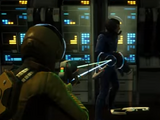
All items (68)
- Actinabulator
- Air purification system

- Barbed wire

- Cement mixer

- Cuckoo clock
- Gravity boots
- Hand scanner

- Identification bracelet
- Identity disc
- Ionic pluto-tele-receptor

- Magnetic manacles
- Magnospanner

- Power generator
- Psychotricorder
- Public announcement system
- Rubindium-transponder transporter recall bracelet

- Shelter kit

- Category:Sports equipment

- Subspace antenna
- Subspace rescue beacon
- Survival kit

- Category:Tools

Boldly Accessorize Your Office With Star Trek Tech Accessories! - SHOP NEW COLLECTION
NEW! Comfort Colors® x Star Trek T-Shirts! - SHOP T-SHIRTS
Discovery Is Back! Gear Up For The Final Season - SHOP COLLECTION
Sign Up & Save 15% Off Your Next Order! - SUBSCRIBE NOW
- Deep Space Nine
Lower Decks
Strange new worlds.
- The Animated Series
The Next Generation
The original series.
- Comfort Colors®
- Star Trek Universe
Election 2024
Personalized, starfleet academy.
- Uniforms & Cosplay
- Hoodies & Sweatshirts
- Long Sleeve T-Shirts
- Kids & Baby
- Bags & Backpacks
- Money Clips
- Phone Cases
- Passport Covers
- Socks & Shoes
- Ties & Tie Bars
- Coffee Mugs
- Bar Accessories
- Beer Steins
- Water Bottles
- Beach Towels
- Kitchen Accessories
- Office Supplies
- Party Supplies
- Pet Products
- Tech Accessories
- Wall Decals
- Certificates
- Electronics
- Tridimensional Chess Set
- The Original Series Delta Personalized Laser Engraved Pint Glass
- Starfleet Academy Personalized Certificate
- Picard Chateau Picard Stemless Wine Glass
- Discovery Disco Men's Short Sleeve T-Shirt
- Space The Final Frontier T-Shirt
- Semper Exploro Hoodie
- Live Long & Prosper Phone Case

Mother's Day

Star Trek Cats

Star Trek: Discovery DISCO T-Shirt

The Wrath of Khan

Star Trek Space The Final Frontier T-Shirt

Star Trek Energize Mug

Star Trek Semper Exploro Hoodie

Star Trek Live Long & Prosper Phone Case

UNLEASH YOUR INNER STARFLEET WITH TECH ACCESSORIES
Star trek tech accessories.

Star Trek: The Original Series Live Long and Prosper Mouse Pad
Save Liquid error (snippets/product-template line 131): Computation results in '-Infinity'%
Boldly go where no mouse has gone before with our Star Trek: The Original Series "Live Long and Prosper" Mouse Pad. Featuring the iconic Vulcan salute and the words "Live Long and Prosper," this mouse pad is a tribute to the famous phrase and gesture from the classic sci-fi series.
Gamers, office workers, and virtually anyone with a computer can find a home for their mouse with this customizable Mouse Pad! The rubbery bottom provides a sturdy grip and the soft polyester fabric top ensures smooth mouse movement.
- Soft 100% polyester surface
- Natural rubber base
- Attention: Avoid placing the pad under direct sunlight to prevent fading.
Ordering Information
- Return Policy: We will gladly accept returns for any reason within 30 days of receipt of delivery.
- Shipping: Ship times are estimates of time in transit after your product leaves the fulfillment center. Some items in your order may ship separately to arrive faster.
- Availability: Ships internationally to most countries around the world.
- Shipping Policy: For more information, see our Shipping Policy .
ST-101690-0001-ST-TOS-LLP
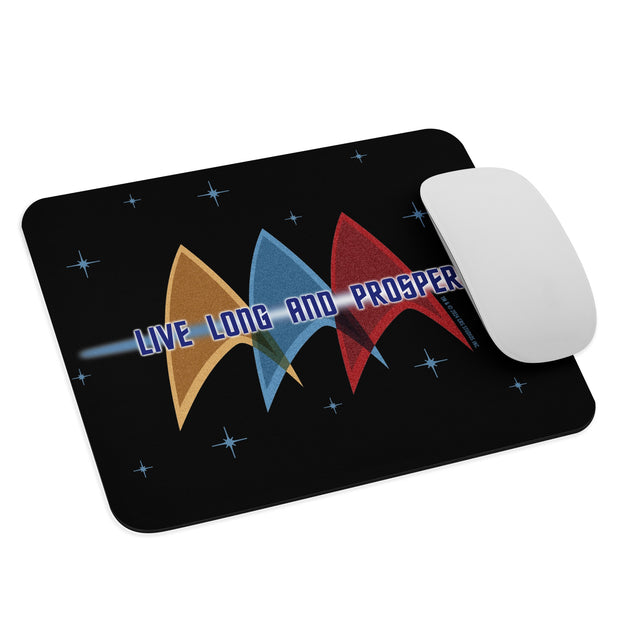
Star Trek: The Original Series Live Long and Prosper Laptop Sleeve
Protect your laptop with the wisdom of Vulcan philosophy with our Star Trek: The Original Series "Live Long and Prosper" Laptop Sleeve. Featuring the iconic Vulcan salute and the words "Live Long and Prosper," this sleeve is a tribute to the famous phrase and gesture from the classic sci-fi series.
- 100% neoprene
- Lightweight and resistant to water, oil, and heat
- Faux fur interior lining
- Top-loading zippered enclosure with two sliders
- Padded zipper binding
WARNING! This product can expose you to chemicals including Bisphenol A (BPA), which is known to the State of California to cause birth defects or other reproductive harm. For more information go to www.P65Warnings.ca.gov.
ST-101692-0001-ST-TOS-LLP
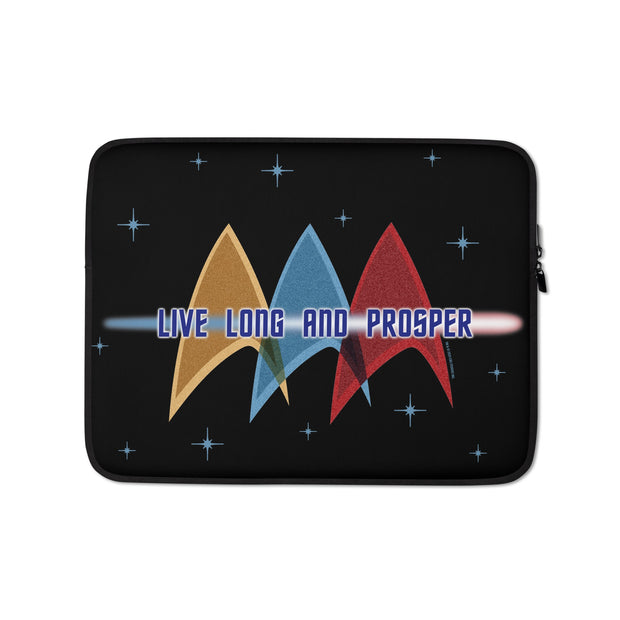
Star Trek The Original Series Live Long and Prosper Gaming Mat
Embark on a mission of exploration and discovery with our Star Trek: The Original Series "Live Long and Prosper" Gaming Mat. Featuring the iconic Vulcan salute and the words "Live Long and Prosper," this mat is a homage to the famous phrase and gesture from the classic sci-fi series.
Turn your gaming setup into a professional gaming station with this reliable and large Gaming Mouse Pad. You’ll never need to worry about adjusting a mouse pad mid-game again! It’s suitable for comfort and precision, with a sturdy grip that won’t slip no matter how intense your match. The quality edge stitching is so fine that the design won’t peel off.
- 100% polyester top
- Rubber non-slip base
- High-quality edge stitching that doesn’t peel
- Non-slip surface
- Rounded edges
ST-101691-0002-ST-TOS-LLP
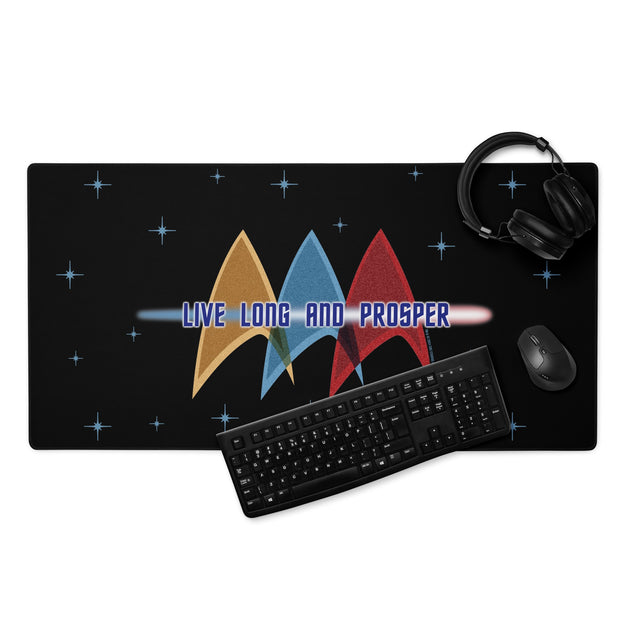
Star Trek: The Next Generation Crew Cats Mouse Pad
Combine your love for Star Trek: The Next Generation and adorable cats with our Crew Cats Mouse Pad. Featuring a playful depiction of the USS Enterprise crew as lovable felines, this mouse pad adds a fun twist to your workspace.
ST-101690-0001-ST-TNG-C
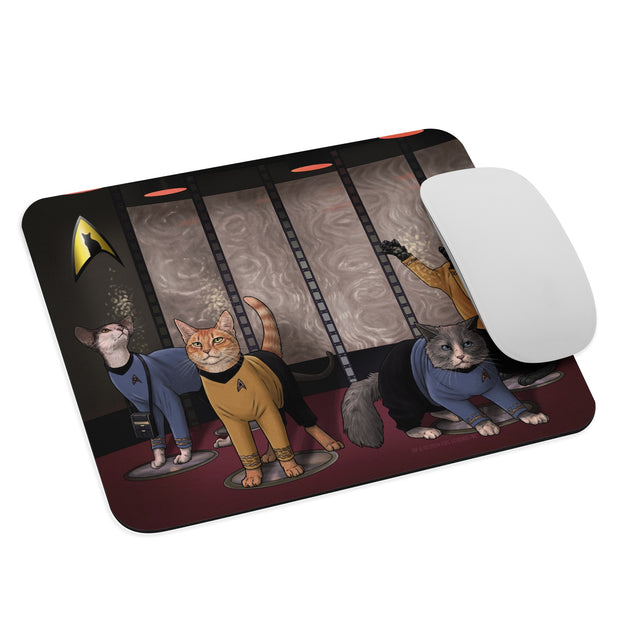
Star Trek: The Next Generation Crew Cats Seat Laptop Sleeve
Protect your laptop with the charming crew of the USS Enterprise, reimagined as lovable cats, with our Crew Cats Seat Laptop Sleeve. This sleeve features a playful depiction of the Star Trek: The Next Generation crew, adding a touch of whimsy to your everyday carry.
ST-101692-0001-ST-TNG-C
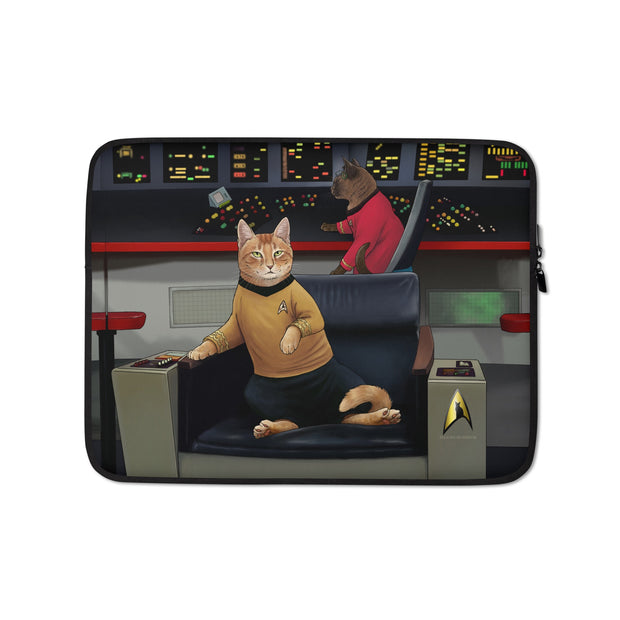
NEW! COMFORT COLORS® x STAR TREK T-SHIRTS
Star trek t-shirts.

Star Trek: Discovery Disco T-Shirt
Step into the adventure with the official Star Trek: Discovery Disco T-Shirt! As seen on the illustrious Michael Burnham and the ever-enthusiastic Sylvia Tilly, this shirt is more than just apparel – it's a symbol of our unwavering commitment to discovery and progress. The Discovery delta graces both sleeves, a proud emblem of our mission. On the front, the word "DISCO" boldly represents the U.S.S. Discovery.
Emblazoned with imagery inspired by pivotal episodes such as "Choose Your Pain," "Magic to Make the Sanest Man Go Mad," and "That Hope Is You, Part 1," this tee encapsulates the essence of our most thrilling adventures.
- Solid colors are 100% Airlume combed and ring-spun cotton
- Pre-shrunk fabric
Care: Machine wash cold, inside-out, gentle cycle with mild detergent and similar colors. Use non-chlorine bleach, only when necessary. No fabric softeners.Tumble dry low, or hang-dry for longest life. Cool iron inside-out if necessary. Do not iron decoration.Do not dry clean.
STDIS-100394-0011-ST-DISCO

Star Trek Live Long And Prosper Comfort Colors Pocket T-Shirt
Embrace the wisdom of the Vulcan salute with our Star Trek Live Long And Prosper Comfort Colors Pocket T-Shirt – a timeless and comfortable homage to the iconic gesture that symbolizes peace, prosperity, and the enduring legacy of Star Trek . Crafted with both comfort and style in mind, this tee is a must-have for Star Trek enthusiasts who want to carry the spirit of Spock's iconic gesture wherever they go.
- 100% ring-spun cotton
- Garment-dyed, pre-shrunk fabric
- Relaxed fit
ST-101711-0031-ST-LLP

Star Trek U.S.S. Enterprise Comfort Colors T-Shirt
Embark on a voyage through the cosmos with our Star Trek U.S.S. Enterprise Comfort Colors T-Shirt – a timeless and comfortable tribute to the iconic starship that has explored the far reaches of space for generations. Crafted with comfort and style in mind, this tee is a must-have for Star Trek enthusiasts who want to proudly display their allegiance to the legendary U.S.S. Enterprise.
ST-101699-0049-ST-ENT
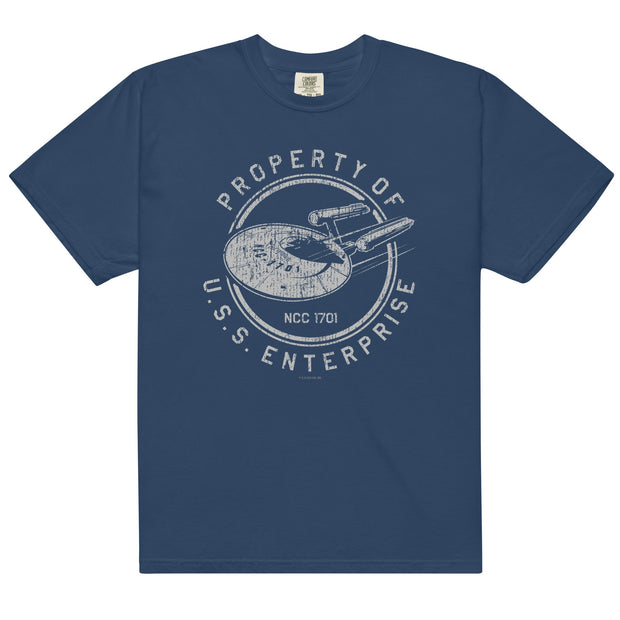
Star Trek Starfleet Academy Comfort Colors T-Shirt
Introducing our Star Trek Starfleet Academy Comfort Colors T-Shirt – a classic and comfortable homage to the prestigious institution that has trained the galaxy's finest officers. Crafted with both comfort and style in mind, this tee is a must-have for Star Trek enthusiasts who want to proudly display their allegiance to the iconic Starfleet.
ST-101699-0085-ST-SFLT

Star Trek: Lower Decks RITOS Adult Short Sleeve T-Shirt
If you are a fan of Star Trek: Lower Decks you will love this RITOS shirt a s worn by Captain Freeman on Star Trek: Lower Decks. The t-shirt features RITOS on the front emulating the DISCO shirts worn on Star Trek: Discovery.
- Fit: This crew neck shirt is comfortable and lightweight.
- Made of: 100% Combed Ring-Spun Cotton and 90/10 Cotton/Polyester in color
- Care: Machine wash cold inside out with like colors and tumble dry low.
- Shipping Policy: For more information, see our Shipping Policy here .
STLD-100011-0013-ST-LD-ritos
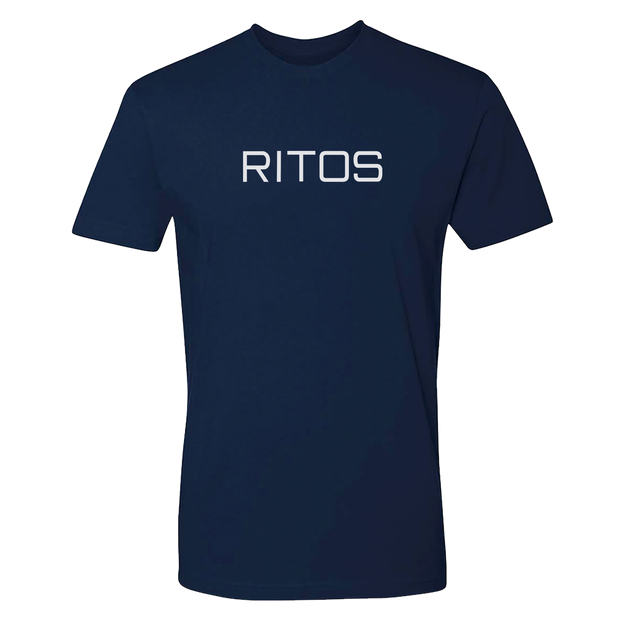
DISCOVERY IS BACK
Featured collection.

Star Trek: The Original Series Ships of the Line Delta Sherpa Blanket
Snuggle in for a night of binge-watching Star Trek with this Star Trek Ships of the Line Delta Sherpa Blanket. Featuring the U.S.S. Enterprise NCC-1701, NCC-1701-D, Deep Space 9, Voyager, and the Star Trek Delta, this blanket is the perfect household accessory for any Star Trek fan.
PRODUCT DETAILS:
- This blanket with soft and smooth mink-touch front with tan Sherpa back is a must have!
- Made of: 100% polyester
- Sizes: 37"x 57", 50"x 60", 60" x 80
- You'll never need another blanket! This blanket is the perfect addition to your home, it looks good and is a nice companion on cool nights.
- Care: Machine wash cold on gentle cycle with mild detergent and similar colors. Tumble dry low or lay flat to dry for the longest life.
- Additional Information: Yarn stitched edges
ST-TOS-SOTL-U111SC87

Star Trek: Discovery Starfleet Command Fleece Zip-Up Hoodie
Join the ranks of Starfleet with the Star Trek: Discovery Starfleet Command Zip Hoodie. This soft hoodie features the badge of Starfleet Command, it will keep you warm through all of your battles.
- Get cozy in this super-soft zip-up hoodie!
- Fit: Comfy and casual fit
- Made of: 50% polyester / 50% cotton
MD-012-004-001-ST-D-SFC

Star Trek Ships of the Line Adult Fleece Joggers
These Star Trek Ships of the Line Joggers let you represent space travel, starship engineering, and exploring the unknown in style. Featuring starships from all Star Trek eras, these joggers are perfect to wear to the gym, around the house, or during your next Star Trek marathon.
- Get ready for that 10K run or take it slow in your backyard - these joggers are sure to make you feel comfortable either way.
- Fit: Relaxed fit with a tapered leg; lower rise on the front and longer rise on the backside.
- Made Of: 60% cotton and 40% polyester pre-shrunk fleece.
- Care: Machine wash cold - inside-out - on gentle cycle with mild detergent and similar colors. Use non-chlorine bleach only when necessary. No fabric softeners. Tumble dry low or hang-dry for longest life. Cool iron inside-out if necessary. Do not iron decoration. Do not dry clean.
9927-ST-TOS-SOTLJ

Star Trek: Discovery Command Training Program Glow In The Dark Adult T-Shirt
Make sure everyone knows that you are one of the select members of Starfleet to be part of the Command Training Program with the DISCO CTP Glow in the Dark t-shirt. As worn by Ensign Sylvia Tilly on Star Trek: Discovery , the t-shirt features the Starfleet CTP logo on both sleeves with CTP DISCO in Glow in the Dark font on the front.
- Made of: 100% preshrunk ring spun cotton
- Care: Machine wash cold inside out with like colors and tumble dry low.
- Additional Information: This tee features modern classic fit. High stitch density for smoother printing surface. 3/4" double-needle topstitched collar. Taped neck and shoulders. Double-needle sleeve and bottom hems. Grey pearlized tear away label.
ST-GD003-64000-BK-S
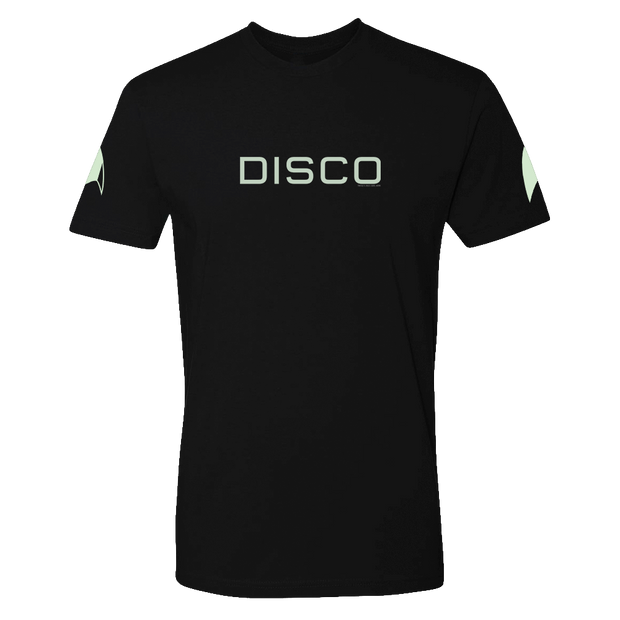
Trending Now
Featured Products

Star Trek: Strange New Worlds Command Delta Badge
This magnetic delta comes to you directly from Star Trek: Strange New Worlds . It is full-size and true to the show's scale in size and finish. The delta features a brushed metal finish. The delta has two vertical magnetic clutches and a back plate to hold it securely in place. While manufactured with FanSets normal attention to detail, this delta is not manufactured as a prop replica.
- True to the show's scale in size and finish
- Ships on May 15, 2024
ST-SNW-R7007211-1-SNW-BDG

Star Trek II: The Wrath of Khan Funko POP! Exclusive - 40th Anniversary Limited Edition Figure
DOORBUSTER DEAL ! Additional discounts do not apply. Shop all doorbusters here!
Commemorate 40 years of Star Trek II: The Wrath of Khan with the Star Trek Shop exclusive edition Funko! This STS exclusive design was chosen by fans across the globe in the first-ever Funko Exclusive Worldwide Fan Vote! The figure features incredible details such as Khan’s iconic pendant, his black gauntlet glove and warrior belt, and comes in a handsome display box complete with the custom Star Trek Shop 40th Anniversary Exclusive sticker of authenticity. The figure will now feature a metallic paint treatment on Khan's glove, his watch, and the chain of his iconic pendant necklace! Khan stands 3 3/4" tall, and comes in the classic Funko display box, complete with the Star Trek Shop 40th anniversary sticker of authenticity. This official 40th Anniversary Funko POP! is available in strictly-limited quantities so don't miss out!
- Apx. 3 ¾” tall vinyl figure
- Includes Star Trek Shop Exclusive sticker on box
- Ages 3+ - WARNING - CHOKING HAZARD - Not intended for children under 36 months
Looking for more? Check out our exclusive bundle , which includes the 40th Anniversary Funko POP! figure, plus our exclusive Admiral Kirk pin and Khan pendant-inspired bottle opener.
Please note:
- Customers may purchase up to 3 units per order of this item.
- All sales are final on this exclusive figure. No returns and no cancellations.
- Please see our special Funko exclusive FAQ for more details on this exclusive presale.
This product ships worldwide. Please visit the official Star Trek Shop in Canada , the UK , or the EU if you're shipping to those destinations. For most other countries, you may complete your purchase here! See here for our Shipping Policy.
- Return Policy: Due to the nature of this special presale event, all sales are final. Payment will be collected at the time of your presale purchase, and returns or cancellations are not permitted.
- Multi-item Orders: Expedited shipping options are not available in the checkout for multi-item orders that include Fast Ship items AND products that are not noted as Fast Ship.
ST-R7003893-1-ST-WOK-FUNKO-US

Star Trek: Picard Magnetic Delta Badge
This magnetic pin comes to you directly from the Star Trek: Picard . It is a full-size delta. While manufactured with FanSets normal attention to detail this pin is not meant to be an exact prop replica. With a bright silver delta over a matte finish black nickel it measures 2 ¾" tall. Revised for screen accuracy this new version of the Picard Delta features a groove in the silver overlay. This magnet lets everyone know how much you enjoy Star Trek: Picard.
Product Details:
- Official Size and Scale!
- Double Clutch Magnetic Back
- Measures 2 ¾” tall
STPIC-R7000287-1-ST-P-D
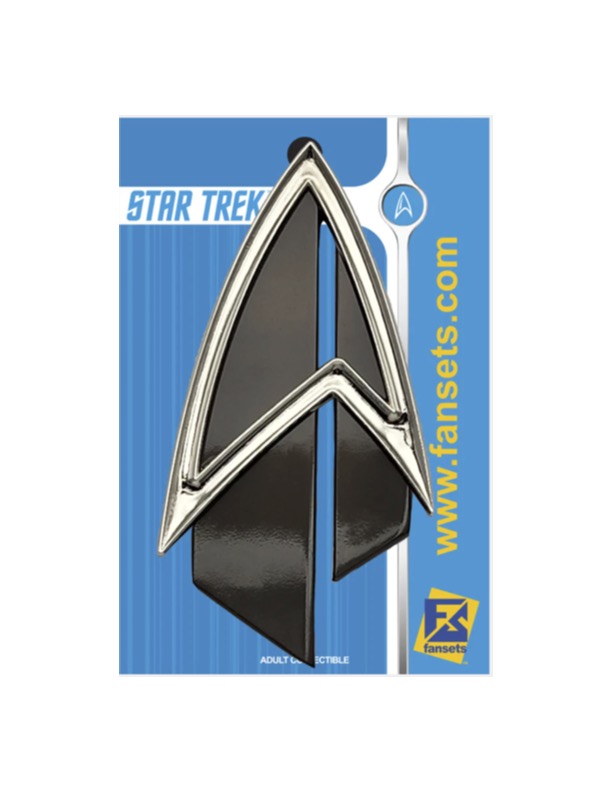
Star Trek: Lower Decks Badge
Forged from resilient materials, the Star Trek: Lower Decks Badge proudly showcases the iconic Delta Shield insignia, adorned with the unique colors and design motifs of the U.S.S. Cerritos crew. Whether you stand among the esteemed senior officers or serve as a humble ensign, this badge serves as a beacon of your dedication to Starfleet and the Lower Decks team.
- This magnetic delta comes to you directly from Star Trek: Lower Decks .
- Measures at 2.25" tall
- The delta features a brushed metal finish.
- The magnet has two vertical magnetic clutches to hold it securely in place.
- While manufactured with FanSets normal attention to detail, this delta is not manufactured as a prop replica.
STLD-R7007212-1-LD-BDG
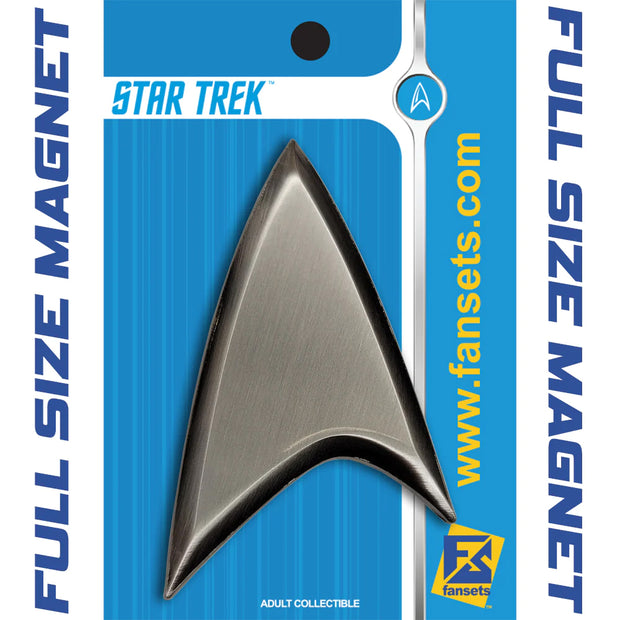
Star Trek: The Next Generation Badge
Star Trek: The Next Generation Delta This delta comes to you directly from Star Trek: The Next Generation. It is a full-size delta that features a matte brushed metal finish. The magnetic version has two horizontal magnets or clutches to hold it securely in place. While manufactured with FanSets normal attention to detail, this delta is not manufactured as a prop replica.
STTNG-R7007210-1-TNG-BDG
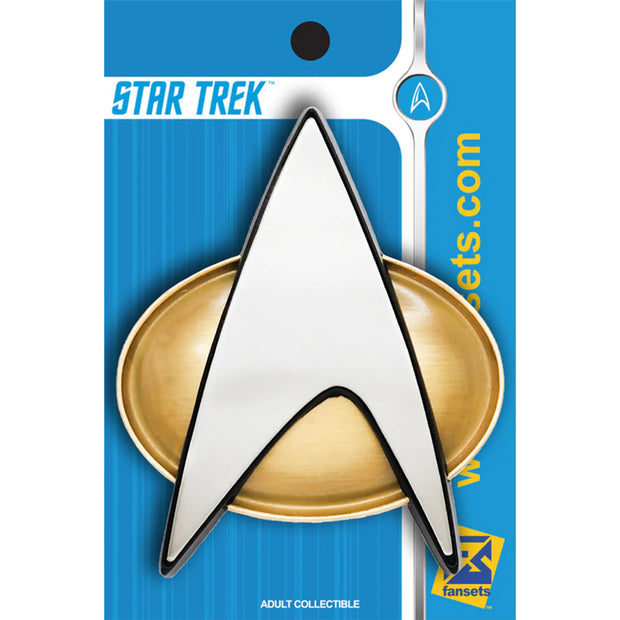
SIGN UP & SAVE!
- The Original Series
- The Animated Series
- The Next Generation
- Deep Space Nine
- Strange New Worlds
- Lower Decks
- Star Trek Movies
- TrekCore on Twitter
- TrekCore on Facebook

Here’s the official description of this new product, produced by Ukonic for Star Trek Unlimited, along with its contents:
Whether you’re a Chief Engineer, or a lower-decker field-tech, you’re never far away from your field kit; that ubiquitous case of indispensable tools which enable you to become the miracle worker you aspire to be. While we may not yet be at the technology for laser-spanners, or portable phase compensators, we do have enough bits, drivers, and pry-tools to help you disassemble and reassemble a variety of 21st century equipment. So when you’re called to come down to the galley and figure out why the food slots keep pouring out nothing but “hot bananas,” make sure to bring your field kit! Like Montgomery Scott used to say, “the right tool for the right job.” If you’re the one everyone turns to in order to fix their technology, be ready for any technical glitch with this Star Trek Engineering Field Kit Tool Set. Jeffries tubes clogged with tribbles? Replicator only spitting out “Tea, Earl Grey, Cold”? This 100-piece electronics tool kit has a solution amongst its 54 different screwdriver bits and dozens of instruments to pry, tweeze, and otherwise coerce computers, phones, tablets, and pads of all types to do your bidding. It’s handy to have around, and it’s also a nice way to say thank you to your personal assistant.
The Next Generation Engineering Field Kit contains the following tools:
pry knife mini suction cup magnetized bit holder prolong bar 6-inch wire cutter 9-millimeter utility knife steel ruler metal prybar electrostatic ring
small suction cup + SIM card tools anti-static cloth 2 plastic prybars 2 pry tools 3 metal prybars 3 precision tweezers 4 spudgers 20 cable ties 54 precision screwdriver bits
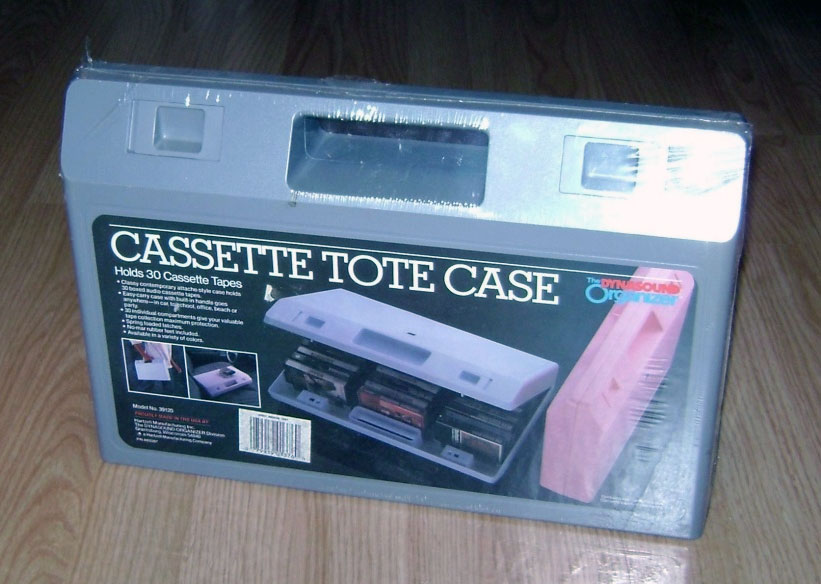
The original prop case used on The Next Generation was a consumer cassette tape carry case, repurposed for use on the television series; the Star Trek Unlimited toolkit is a new molded-plastic case created for this new product.
If you want to get your Starfleet engineering action on, you can order this new Star Trek: The Next Generation Engineering Field Toolkit from Star Trek Unlimited today for $89.99.
- Star Trek Unlimited
- Star Trek: The Next Generation
- Trek Merchandise
Related Stories
New star trek: discovery photos — “mirrors”, interview — sonequa martin-green on burnham’s “face the strange” encounter, lost-for-decades original star trek uss enterprise model returned to roddenberry family, search news archives, new & upcoming releases, featured stories, star trek: lower decks cancelled; strange new worlds renewed for season 4, our star trek: discovery season 5 spoiler-free review.
TrekCore.com is not endorsed, sponsored or affiliated with Paramount, CBS Studios, or the Star Trek franchise. All Star Trek images, trademarks and logos are owned by CBS Studios Inc. and/or Paramount. All original TrekCore.com content and the WeeklyTrek podcast (c) 2024 Trapezoid Media, LLC. · Terms & Conditions

Login to my account
Enter your e-mail and password:
New customer? Create your account
Lost password? Recover password
Recover password
Enter your email:
Remembered your password? Back to login
Create my account
Please fill in the information below:
Already have an account? Login here
Your cart is empty
- Accessories
- All Products
- Campaigns & Adventures
- Supplements
- Fantasy Grounds
Star Trek Adventures Tabletop RPG
232 products
Starfleet needs a new crew! Welcome to your new assignment, Captain. Your continuing mission, to explore strange new worlds, seek out new life and new civilizations, to boldly go where no one has gone before. Star Trek Adventures is a Tabletop RPG where new discoveries await explorers of Starfleet. Browse below for the roleplaying game, miniatures, dice, character sheets, game tiles & boards, free PDFs and accessories.

Recently viewed
- Opens in a new window.
Net Orders Checkout
Shipping address, shipping methods.
Building the Tricorder: The race to create a real-life Star Trek medical scanner

Its vision of romantic encounters with aliens and plagues of tribbles may not have come to pass just yet, but Star Trek has proved surprisingly accurate in predicting the future in other ways.
- I replaced my boring workouts with Meta Quest's Supernatural app, and can't imagine going back
- This Finnish startup's new VR headset rivals Apple's Vision Pro - and business users will love it
- Meta's $500 Quest 3 is the mainstream VR headset I've been waiting for, and it delivers
- I tried Apple Vision Pro and it's far ahead of where I expected
- The best VR headsets right now (and they're not just from Meta)
When it comes to technology, the show's gadgets have already become reality in several cases: its communicator predicted the clamshell mobile phone, the food replicator was made real with 3D food printing , and Captain Kirk was using voice input long before Alexa became a household name.
But of all Star Trek's technological imaginings, it's the Tricorder that continues to capture the popular and scientfic imagination: a handheld medical device that could be used to analyse a patient, helping doctors diagnose and treat the crew on the bridge and beyond.
No blood tests, no X-rays, no genetic sequencing: Star Trek's doctors could just point their tricorders at the patient and seconds later work out if they'd succumbed to a cold or the Quazulu VIII virus.
The Tricorder continues to fascinate because it magically solves some of the problems about medicine we still have today: it takes too long, it's expensive, it's uncertain, and the times you need it most -- when you're far from home -- is often when it's unavailable.
People have been trying to make replicate elements of the Tricorder since the 1990s. But it's only in the last few years that the dream of creating a genuine Tricorder-type device has seemed within reach.
The first signs that a medical Tricorder could be more than a sci-fi fantasy coincided with the emergence of the first serious smartphones and tablets. Back in 2007, MIT researchers used a Nokia 770 as the basis for a Tricorder , displaying information from sensor networks, while a few years later, a rash of medical peripherals released for the iPhone offered the hope that Apple's mobile could be turned into a real-life Tricorder .
Such early discussions focused on customising existing mobile hardware to a medical diagnostic device; the first standalone device would be a few years further on.
SEE MORE ON OUR NHS REPORT: VR, AR and the NHS: How virtual and augmented reality will change healthcare
One of the first companies to make a serious attempt at creating a Tricorder was Scanadu, which released a device called the Scout in 2015 .The Scout could measure a handful of vital signs -- blood pressure, heart rate, blood oxygen saturation, and temperature -- by being held up to a patient's forehead. It's not quite the Tricorder's no-touch technique, and had no diagnostic capabilities, but it was arguably further towards such a device than any hardware before it. After raising $1.7m on Indiegogo, and several million dollars more from investors , the Scout eventually went on sale. However, the company had released it under the banner of a " research device for investigational use ". When it subsequently failed to win FDA approval -- for unspecified reasons -- the research effectively came to an end, and devices were bricked, leaving buyers furious .
Special Feature
The nhs and technology: how innovation is revolutionizing healthcare (free pdf).
AI and robots, IoT, virtual and augmented reality, and wearables—all are innovative technologies that could boost healthcare and productivity across the NHS. This ebook looks at how these technologies are being implemented and their current and future impact on health services.
Despite the Scout's difficulties, there was no shortage of companies that were looking to succeed were Scanadu had failed.
As befits a potentially game-changing and technologically-complex device, the Tricorder concept had caught Google's eye. Back in 2014, the head of life sciences at what was then Google X, the company's moonshot division, announced a cancer-detection system that would lay the foundations for the creation of a Tricorder. The system that Dr Andrew Conrad announced aimed to use magnetic nanoparticles that would attach themselves to cancer particles; a separate wrist-worn device would measure the particles to detect cancer. The system would over time form part of a real-life Tricorder, Conrad said.
"Instead [of] going to the doctor who says, 'Let me draw blood and in three days I'll call you if there's anything wrong,' the doctor can look and say, 'Oh, I just checked all your blood over this last year, and it looks like your kidneys are good, your liver is good, I don't see any indication of oncologic cells, pretty good, thanks.' ... We want to have a Tricorder where Dr. McCoy will wave this thing and say, 'Oh, you're suffering from Valerian death fever.' And he'd then give some shot in a person's neck and they'd immediately get better. We won't do the shots -- our partners will do the shots. But we're hoping to build the Tricorder," he told Medium at the time.
Since then, Google and its X division have been reorganised: Google's life sciences arm has become Verily, now overseen -- along with Google and other Google spinouts, including Calico -- by a new parent company Alphabet . Conrad remains head of Verily, but his dream of a Star Trek-grade medical device has not come to pass: Verily has yet to showcase any progress on building either the cancer-detection system or the Tricorder itself.
A spokesperson for Verily says its nanoparticles research is still active, but added it had experienced difficulties in the past: "Our nanoparticle research is focused on developing nanoparticles that demonstrate consistent properties. We found that nanoparticles we purchased from third-party manufacturers have been unreliable in research due to inconsistencies."
The $10m prize
Arguably one of the biggest stimulants for building a Tricorder came when chipmaker Qualcomm sponsored the Tricorder XPRIZE , a competition intended to help foster the creation of innovative medical hardware.
Rather than asking for a machine that can read vitals to help diagnose any number of illnesses, the XPRIZE asked for hardware that could diagnose a set list of 13 medical condition, including anaemia and diabetes, as well as monitor a handful of vital signs.
The prize, launched in 2011, was won last year by Basil Leaf Technologies with a device called DxtER , a small unit with a range of specific medical peripherals, including a sensor for heart and lung sounds, an ECG monitor for measuring heart rate and rhythm, and a device for analysing blood glucose and white cell count, a sign of infection and inflammation when raised.
By winning the prize, the inventors -- a group of siblings and others led by Philadelphia-based emergency room physician Basil Harris -- received a $2.6m grant to help take the DxtER from concept to commercialisation.
However, the first publicly available device based on this technology is likely to have a far smaller scope than Bones' Tricorder. Basil Leaf Technologies is working on creating a monitoring device for a single disease state, congestive cardiac failure (CCF), that a patient could keep with them at home to help monitor the progress of their condition. The aim is for a person with CCF, a chronic condition, to interact with the device a couple of times a day, and that information to be sent back to a medical professional to review. With such longitudinal monitoring, a doctor can monitor the patient's progress regularly without having to ask them to take time out of their days to come in for regular check-ups.
"A diagnostic device that can diagnose one of 13 medical conditions is not really that viable -- a first year medical resident can diagnose 75 to 100 medical conditions. We just designed something to win a prize, but it's not something that's useful out in the marketplace yet. And if you think about how the FDA in the United States approves medical devices, if we sought an approval for a medical device that did a large collection of medical conditions, it would take aeons to be approved. From a strategic point of view, we changed our strategy and said let's focus on one disease state," Phil Charron, head of user experience at Basil Leaf Technologies, tells ZDNet.
SEE MORE ON OUR NHS REPORT: Why the NHS is killing paper records to save lives
Nonetheless, Basil Leaf Technologies is still working towards creating a Tricorder in the way that most people think of it: a single device that can diagnose a range of conditions. For a real-life Tricorder to serve as a universal diagnostic tool in the way that Star Trek envisioned, it would need to be able to analyse far more biomarkers than the DxtER currently does.
Handily, scientists are also working on expanding the capabilities of Tricorder-like devices. Earlier this year, researchers from the University of Glasgow created a handheld sensor device based on a CMOS chip that can analyse a number of metabolites in blood or urine, analysing them to diagnose conditions including heart attacks.
Elsewhere, companies are working on creating Tricorder type hardware with a focus on infectious disease: the Q-POC, made by QuantumDx, is expected to launch next year, and brings handheld diagnostics for bacterial and viral infections. The idea of the Q-POC is putting short-read genetic sequencing into a device the size of a smartphone: with a sample of bodily fluid, the reader could pick up not only the nature of an infection, like TB, but also its resistance to particular drugs. The technology already exists and is in common use, but shrinking it down to a device that can fit in a pocket is QuantumDx's real challenge.
The fact that the company has had to put back the Q-POC's launch date from 2016 to 2019 shows that miniaturisation is no small task. In fact, it's one of the key challenges that exists for building a Tricorder: the technology that doctors use to diagnose illnesses already exists, but it often exists in large, discrete machines, often spread around different parts of a hospital. Tricorders have to bring all of those capabilities into a single device that can be carried by one person.
"Most of the technologies that exist out there we can turn into something we can put into the patient's hands, I think that [the challenge] is more about shrinking the technologies that exist. A lot of the things that a physician can do in a regular exam room we put in a Tricorder. Labs and radiology -- that's the difficult thing to shrink down into a Tricorder," Basil Leaf Technologies' Charron says.
As well as difficulties with hardware, creating the right software for Tricorders is likely a number of years away. Creating algorithms that can diagnose certain conditions from a tight set of physical biomarkers is one thing, but there's an old adage in medicine that 'if you listen hard enough, the patient will tell you the diagnosis'. To be a universal diagnostic device, Tricorders will not only have to interpret test results, they'll also need software that knows the right questions to ask and unpick the answers they get back: a patient saying they have a tight chest pain and a sharp chest pain might sound similar, but could be the difference between a full blown heart attack or pericarditis -- a painful, but relatively benign, infection of the heart's covering.
"Our expectations about the medical tricorder stem from Star Trek and it's never a good decision to base expectations on science fiction, even though many technologies have become real from science fiction in the 21st century," says Dr Bertalan Meskó, director of The Medical Futurist Institute . And it doesn't mean we won't need doctors, Meskó says.
"There is a reason why we train medical professionals for decades and artificial intelligence-based algorithms, tricorders and many other advanced technologies are designed to upgrade their capabilities so they can use their unique vision, expertise and experience while focusing on the patients. The tricorder should make this possible instead of replacing what physicians do today."
Though the challenges to a medical Tricorder remain substantial, technology companies show no signs of waning enthusiasm for the device. That's because the potential applications for such hardware are huge. Many of the companies working on the tech today envision their machines being used by healthcare staff that aren't doctors to go do some of the run-of-the-mill diagnostic legwork, calling in doctors only for the trickiest of cases.
And, aside from managing consultants' workloads better, Tricorders could potentially make a much more significant contribution to medicine. Imagine an area -- be it in rural Europe or rural Africa -- where population density is lower, and the provision of medical care is even more sparse. Instead of having to drive for hours or even days to find a doctor the next time you take sick, a Tricorder in the home or local clinic could help you to decide whether you need to get to the nearest A&E or take a couple of aspirin and sleep off the fever.
"A working tricorder could bring about a new era in medicine," says Meskó.
Instead of expensive machines and long waiting times, information would be available immediately. Physicians could scan a patient, or patients could scan themselves and receive a list of diagnostic options and suggestions. "Imagine the influence it could have on underdeveloped regions. It should not substitute for medical supervision, but when there is none it comes in handy. Also, it would make the biggest promise of digital health real: making patients the point-of-care. Technologically, it's absolutely viable," says Meskó.
Perhaps the most interesting use of the Tricorder takes us right back to the device's sci-fi conception. Should humans ever attempt more long-distance space travel, a Tricorder would be a must: a manned mission to Mars could see astronauts travel for weeks or months without access to the full repertoire of medical support.
A sufficiently advanced Tricorder could help astronauts keep in good health during the journey. Without it, it's hard to imagine how the next generation of astronauts will be able to boldly go where no one has gone before.
PREVIOUS AND RELATED COVERAGE
Smart watches, fitness trackers and the NHS: Are wearables just what the doctor ordered?
While more and more of us are wearing fitness trackers, the real benefits of wearables may come from another quarter.
Why the NHS is killing paper records to save lives
The NHS still relies on paper for many patient records. Getting rid of it could free up time, and money.
Robots and the NHS: How automation will change surgery and patient care
The rise of robots is inevitable in healthcare, but for now, keeping it simple is just what the doctor ordered.
VR, AR and the NHS: How virtual and augmented reality will change healthcare
Against a background of growing enterprise adoption of virtual reality, mixed reality and similar technologies are beginning to gain a foothold in the NHS.
AI and the NHS: How artificial intelligence will change everything for patients and doctors
The rise of artificial intelligence is set to reshape the health sector as we know it, from back office to doctor's office.
IoT and the NHS: Why the Internet of Things will create a healthcare revolution
The Internet of Things must be one of the most high-profile technology trends of the last five years. Could IoT be the backbone of the NHS of the future?
NHS and technology: Making the case for innovation
Physician, reboot thyself! The health service is caught between its creaky past and a shiny future. But change is needed, and fast.
Healthcare security nightmare: UK's NHS lost nearly 10K patient records last year (TechRepublic)
Despite having electronic record systems in place, 94% of NHS Trusts still use handwritten notes for patient record keeping, according to a report from Parliament Street.
Omron Healthcare Blood Pressure Monitor (CNET)
This gadget from Omron Healthcare is worn around your wrist, displays the time, tracks your steps -- and monitors your blood pressure, too.
Meta opens its Quest OS to third-party headsets, including from Asus and Lenovo
The best android smartwatches you can buy: expert tested, humane ai pin: what went wrong and how it can be fixed (before it's too late).

- View history

Phlox carrying a medical kit
Medkits , also known as medikits or medical kits , were pouches used by Starfleet medical practitioners and officers that contained medical equipment for landing parties and away teams . ( ENT : " Terra Nova "; TNG : " Skin Of Evil ") In 2269 , Captain James T. Kirk referred to Leonard McCoy 's medkit as a "little black pouch". ( TAS : " Once Upon a Planet ")
In 2151 , Captain Jonathan Archer told Doctor Phlox to take his medical kit with him when the two prepared to transport to the surface of Terra Nova to negotiate with the Novans . This medical kit was a carrying case with a strap, carried over one's shoulder . ( ENT : " Terra Nova ")
United Earth scientists took medical kits with them on their missions . In 2153 , the Arctic Archaeology Team had a medical kit in one of their research modules . ( ENT : " Regeneration ")
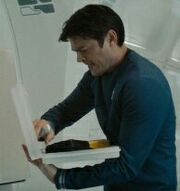
McCoy rummaging through a medkit
In the alternate reality , Leonard McCoy brandished a transparent medkit branded with the Starfleet insignia while chasing an ill James T. Kirk to the bridge of the USS Enterprise . ( Star Trek )
In the 2260s a medkit was carried separately from the medical tricorder as a supplement. It contained a hypospray preloaded with up to six drugs in suspension, such as cordrazine , Masiform D , a neural paralyzer / melenex , and tri-ox compound . Also included was a spray applicator , a medical scanner , and a palm-sized reader tube . ( citation needed • edit )
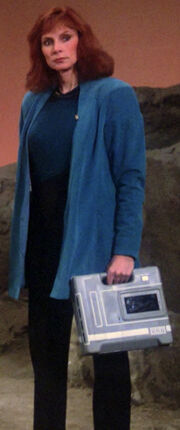
Doctor Beverly Crusher holds a 2360s-era medikit
In the 2370s , the kits were more complex, containing a medical tricorder, a hypospray, a dermal regenerator , and a trauma kit for emergency medical situations. ( citation needed • edit )

Two Starfleet medikits: standard and compact
Medkits were often kept in strategic positions around Starfleet vessels and bases . The USS Voyager had one located behind the tactical console on the bridge. ( VOY : " Projections ")
A more compact medkit was also employed by Starfleet. It was about the same height as a standard medkit, but not as wide. ( VOY : " The Gift ")
While stranded on a moon in the Gamma Quadrant , the members of the away team were held prisoners by the Ennis . Doctor Julian Bashir tried to get his medkit from the Ennis Nima back to treat the wounded Major Kira Nerys . ( DS9 : " Battle Lines ")
The USS Enterprise -D kept extra medkits on hand for relief missions. To prove her loyalty to the Maquis , Ro Laren stole a large quantity of them in 2370 . ( TNG : " Preemptive Strike ")
In 2373 , Jake Sisko assisted Julian Bashir in distributing medkits to the station's medical staff prior to the Second Battle of Deep Space 9 . ( DS9 : " Call to Arms ")
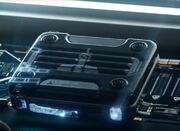
Emil replicates a medkit
By 2399 , a medkit model labeled for use by the Emergency Medical Holographic program could be replicated on demand aboard La Sirena , which included a dermal regenerator . ( PIC : " The End is the Beginning ")

La Sirena 's "old" med kit
Though when replicators were unavailable, La Sirena did carry an "old" fashioned physical kit onboard. Dr. Agnes Jurati used the "old" kit to treat retired admiral Jean-Luc Picard aboard after the ship crashed on Coppelius . ( PIC : " Et in Arcadia Ego, Part 1 ")
External link [ ]
- Medkit at Memory Beta , the wiki for licensed Star Trek works
- 2 ISS Enterprise (NCC-1701)
- VisualEditor
- View history
Players are able to utilize various types of Equipment on their ship , captain and bridge officers . The equipment chosen will have an effect on the mission as they face many foes from many different races. The correct choice of equipment could be the difference between success and failure.
These can be bought or found in combat as loot. Unwanted equipment can be sold to vendors or on the exchange , traded with other players or salvaged . Note that Bound items cannot be sold on the Exchange or traded with other players.
- 1 Mark and Quality
- 3 Personal equipment
- 4 Starship equipment
Mark and Quality [ | ]
The stats of an item are affected by its Mark (Mk) and Quality . The Mk corresponds directly to the minimum rank a player must hold in order to be able to equip the item. The higher the mark number, the greater the items' stats and the higher the minimum level of the player that is allowed to equip this item. Mks increase by 2 per rank. So a Mk I item is usable by a Lieutenant , Mk III requires a Lieutenant Commander , Mk IV a Commander and so on. Level Scaling Equipment is an item that increases its stats with your rank automatically (as such, do not need to be upgraded), these are denoted by an infinity (∞) sign in place of a mark.
The quality of an item represents how many modifiers (mods) an item has. An example of a modifier is "[Acc]", which is a boost to accuracy rating. Uncommon items have 1 modifier, Rare has 2, Very Rare has 3, Ultra Rare has 4, and Epic has 5. 2 of the same mod is shown with a "x2" after it. So a Very Rare Mk VIII item requires a Captain to use and has 3 modifiers (lets say 1 Accuracy modifier and 2 Critical Hit modifiers). Such an item would display like this: [ Phaser Split Beam Rifle Mk VIII [Acc] [CrtH]x2 ] .
The Gear Upgrade System enables players to improve the quality of their gear items by increasing both their mark and quality. It can be accessed through a button on the bottom-left of the inventory window, or via the right-click menu of upgradable items while they are not equipped.
Re-engineering allows an item's modifier to be re-rolled at a scaling cost of Dilithium and Salvage . The exact cost depends on how many available mods you wish to re-roll. The re-rolling is random, but it will not re-roll to the existing mod.
Crafting [ | ]
Many items can be crafted by the player using the Research and Development (R&D) system. It uses R&D Materials to create R&D Components , both of which are in turn needed to craft various items , including "tech upgrade kits" for the aforementioned upgrading of exiting items.
Personal equipment [ | ]
Personal equipment is applied to your captain and bridge officers for use on ground maps. Note that bridge officers cannot use kits.
Starship equipment [ | ]
- 2 Playable starship
- 3 Reputation System
Equipment Cards
Below are some Equipment cards I’m creating. I use several rules from Conan and Infinity, and there for use several of their qualities. Tell me what you think of them. Equipment Cards Updated 18/10/2020 Cards - Single Star Trek.pdf (2.6 MB) The following items included: Ahn’woon Bat’leth Chaka D’k tahg Explosive charge Force Shield Guard Drone Hazard Suit Infinity Modulator Lirpa Mek’leth Phaser - Type 1 Phaser - Type 2 Phaser - Knife Phaser Rifle - Assault Rifle Phaser Rifle - Enhanced Compression Rifle Phaser Rifle - Type 3 Retractable Blade Tactical Eye Display

I agree with @MisterX - seriously nicely done, but keep the fancy typeface for the headings (including the titles of the qualities and effects if your software allows).
Thanks I made some modifictions based on the feedback. I uploaded it in my first post. More material is comming

I added more weapons to the list. And uploaded to my first post
Expanded the number of weapons and added some armor and other gear. Uploaded it in my first post
Added the following items and uploaded it in my first post: Bat’lethand Chaka Explosive Charge Guard Drone
Related Topics

IMAGES
VIDEO
COMMENTS
Main page; Contents; Current events; Random article; About Wikipedia; Contact us; Donate; Pages for logged out editors learn more
Star Trek: The Original Series Command Uniform Beach Towel. $39.95. 1 2 3 … 9. You will feel like the captain of your favorite spacecraft when you dress your home and office in official Star Trek gear! Shop cozy blankets, stylish throw pillows, beautiful wall art, and unique office gear featuring Star Trek: The Next Generation, Starfleet ...
When "Star Trek: The Next Generation" thrust the love of everything "Star Trek" back into popular culture, the quirky Mr. Spock and crass Bones McCoy and others were supplanted by a new cast. ... This kind of sensitivity (800 times more sensitive than sensing equipment currently used in medical labs) could revolutionize the way doctors diagnose ...
4. Tractor Beams. Star Trek 's tractor beam, a concept that has appeared in science fiction since the 1930s, rests on the idea of a high powered energy beam locking on and attracting a foreign object, spaceship, or person. The idea, originally called an 'attractor beam', has appeared in a wide range of science fiction stories in the years ...
Focused Ultrasound Surgery. Paramount Pictures. This surgical technique is a non-invasive way to destroy unwanted masses within the body (like uterine fibroids) without harming the surrounding ...
Here are 12 gizmos used on the Star Trek television shows that are now becoming real. 1. Food Replicator. Captain Jean-Luc Picard used to say "Tea, Earl Grey, hot!" and it would be replicated ...
The Starfleet tricorder was the versatile, portable sensing device developed by Starfleet R&D specifically for use by Federation Starfleet personnel. Varying models of the Starfleet tricorder were put into service, beginning as early as the 23rd century through the 24th century, lasting well into the 32nd century. In service aboard the early 2230s ship the USS Kelvin, the tricorder was a large ...
Subspace. In the Star Trek fictional universe, subspace is a feature of space-time that facilitates faster-than-light transit, in the form of interstellar travel or the transmission of information. Faster-than-light warp drive travel via subspace obeys different laws of physics. The name "subspace" has also been adopted and used in other fictional settings, such as the Stargate franchise, The ...
4. Tricorders. The tricorder is another important piece of equipment seen in the Star Trek original series. The multifunctional handheld device can be used to sensor scan an environment or individual and record data for analysis. In particular, Dr. Leonard "Bones" McCoy often uses it to diagnose and cure patients.
A tricorder is a fictional handheld sensor that exists in the Star Trek universe. The tricorder is a multifunctional hand-held device that can perform environmental scans, data recording, and data analysis; hence the word "tricorder" to refer to the three functions of sensing, recording, and computing.In Star Trek stories the devices are issued by the fictional Starfleet organization.
This page lists equipment. A friendly reminder regarding spoilers!At present the expanded Trek universe is in a period of major upheaval with the continuations of Discovery and Prodigy, the advent of new eras in gaming with the Star Trek Adventures RPG, Star Trek: Infinite and Star Trek Online, as well as other post-57th Anniversary publications such as the ongoing IDW Star Trek comic and spin ...
Medical equipment in 2374. A medical case with perishable cultures in 2364. A medical device or medical supply was a form of medical technology intended for use to diagnose, treat, cure or prevent disease or other conditions in lifeforms.Where medical equipment was designed to aid in the diagnosis, monitoring or treatment of a medical conditions.
STO EQUIPMENT AND TRAIT SELECTOR. STO Equipment and Build Selector, called SETS, is a new and innovative planning tool for ship and ground builds as well as space and ground skill trees for Star Trek Online™ developed by the STO Community Developers. Our main goal is to provide an easy and intuitive platform for optimizing every single aspect ...
Introducing the Star Trek: The Original Series Science Uniform Tough Phone Case, the ultimate accessory for devoted Star Trek enthusiasts.Crafted with precision and attention to detail, this officially licensed case allows you to proudly display your allegiance to the United Federation of Planets.
Welcome To The Official Star Trek Store! Find Apparel, Drinkware, & Accessories For Your Favorite Star Trek Series. Featuring Exclusive Merchandise from Star Trek: Discovery, Star Trek: Picard, Star Trek: The Original Series, & More. Shop Now!
The original prop case used on The Next Generation was a consumer cassette tape carry case, repurposed for use on the television series; the Star Trek Unlimited toolkit is a new molded-plastic case created for this new product. If you want to get your Starfleet engineering action on, you can order this new Star Trek: The Next Generation Engineering Field Toolkit from Star Trek Unlimited today ...
MADE TO PERFORM. Rooted in cardio, Star Trac has grown to innovate products that keep people moving and create lifelong health and fitness habits. As we focus on intuitive designs and reliability, we go the distance to provide fitness solutions for the best workout experiences. With dynamic technology and OpenHub connectivity, Star Trac ...
An osteogenic stimulator was a medical tool used to stimulate the natural repair of broken or fractured bones. Some shuttlecraft were equipped with osteogenic stimulators as part of their emergency medkits, but they could only heal minor fractures - more serious fractures required treatment at a medical facility on board a starship or at a starbase. The model of dermal regenerator used on ...
Star Trek Adventures is a Tabletop RPG where new discoveries await explorers of Starfleet. Browse below for the roleplaying game, miniatures, dice, character sheets, game tiles & boards, free PDFs and accessories. Starfleet needs a new crew! Welcome to your new assignment, Captain. Your continuing mission, to explore strange new worlds, seek ...
One of the first companies to make a serious attempt at creating a Tricorder was Scanadu, which released a device called the Scout in 2015 .The Scout could measure a handful of vital signs ...
Medkits, also known as medikits or medical kits, were pouches used by Starfleet medical practitioners and officers that contained medical equipment for landing parties and away teams. (ENT: "Terra Nova"; TNG: "Skin Of Evil") In 2269, Captain James T. Kirk referred to Leonard McCoy's medkit as a "little black pouch". (TAS: "Once Upon a Planet") In 2151, Captain Jonathan Archer told Doctor Phlox ...
Players are able to utilize various types of Equipment on their ship, captain and bridge officers. The equipment chosen will have an effect on the mission as they face many foes from many different races. The correct choice of equipment could be the difference between success and failure. These can be bought or found in combat as loot. Unwanted equipment can be sold to vendors or on the ...
Below are some Equipment cards I'm creating. I use several rules from Conan and Infinity, and there for use several of their qualities. Tell me what you think of them. Equipment Cards Updated 18/10/2020 Cards - Single Star Trek.pdf (2.6 MB) The following items included: Ahn'woon Bat'leth Chaka D'k tahg Explosive charge Force Shield Guard Drone Hazard Suit Infinity Modulator Lirpa Mek ...